外文参考文献
外文参考文献译文及原文【范本模板】
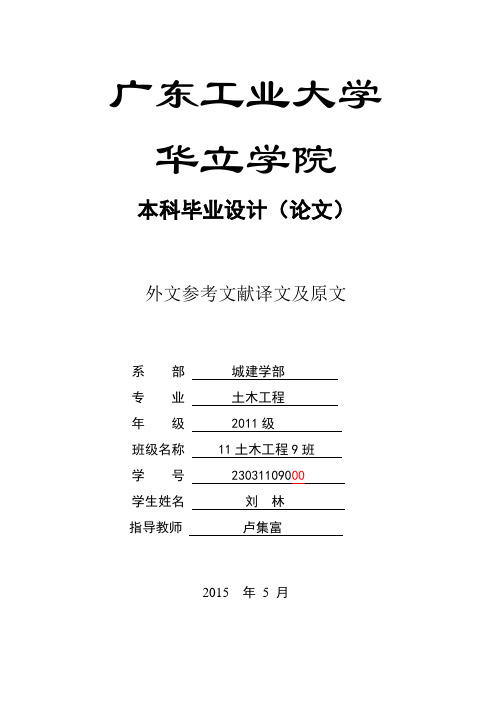
广东工业大学华立学院本科毕业设计(论文)外文参考文献译文及原文系部城建学部专业土木工程年级 2011级班级名称 11土木工程9班学号 23031109000学生姓名刘林指导教师卢集富2015 年5 月目录一、项目成本管理与控制 0二、Project Budget Monitor and Control (1)三、施工阶段承包商在控制施工成本方面所扮演的作用 (2)四、The Contractor’s Role in Building Cost Reduction After Design (4)一、外文文献译文(1)项目成本管理与控制随着市场竞争的激烈性越来越大,在每一个项目中,进行成本控制越发重要。
本文论述了在施工阶段,项目经理如何成功地控制项目预算成本。
本文讨论了很多方法。
它表明,要取得成功,项目经理必须关注这些成功的方法.1。
简介调查显示,大多数项目会碰到超出预算的问……功控制预算成本.2.项目控制和监测的概念和目的Erel and Raz (2000)指出项目控制周期包括测量成……原因以及决定纠偏措施并采取行动。
监控的目的就是纠偏措施的。
.。
标范围内。
3.建立一个有效的控制体系为了实现预算成本的目标,项目管理者需要建立一……被监测和控制是非常有帮助的。
项目成功与良好的沟通密。
决( Diallo and Thuillier, 2005).4.成本费用的检测和控制4.1对检测的优先顺序进行排序在施工阶段,很多施工活动是基于原来的计……用完了。
第四,项目管理者应该检测高风险活动,高风险活动最有。
..重要(Cotterell and Hughes, 1995)。
4.2成本控制的方法一个项目的主要费用包括员工成本、材料成本以及工期延误的成本。
为了控制这些成本费用,项目管理者首先应该建立一个成本控制系统:a)为财务数据的管理和分析工作落实责任人员b)确保按照项目的结构来合理分配所有的……它的变化-—在成本控制线上准确地记录所有恰..。
国标外文参考文献格式

国标外文参考文献格式外文参考文献是学术研究中不可或缺的重要资源,对于专业学科的发展和创新起到了积极的推动作用。
为了确保引用外文参考文献的准确性和一致性,国际上形成了一套规范的引用格式,称为国标外文参考文献格式。
本文将详细介绍国标外文参考文献格式的要求和规范,以帮助读者正确引用外文参考文献。
一、作者格式:在引用外文参考文献时,作者的格式与中文参考文献有所不同。
对于单一作者,直接写出作者的姓氏、名字即可。
对于多位作者,需要列出所有作者的姓氏、名字,用逗号隔开。
如果作者数量超过三个,则只需写出前三位作者,并在最后添加“et al.”表示等等。
如果文献无法确定作者,则可以使用“Anon.”表示匿名。
二、文献题目格式:在引用外文参考文献的题目格式方面,根据国标规定,应使用斜体的标题。
对于文章、论文等,只需使用首字母大写的格式。
对于书籍、期刊等,需要将所有主要词汇的首字母大写。
同时,需要注意将冒号、感叹号等标点符号保持原样。
三、出版信息格式:在引用外文参考文献时,出版信息的格式需要按照一定规范进行书写。
首先是出版地点,应写明城市及国家或地区,如果为美国的城市,则需要写明州名。
然后是出版社的名称,需准确无误地书写出来。
对于期刊文章,需要写明期刊的名称、卷号、期号及所属年份。
对于论文或会议文章,则需要标明论文所属的期刊或会议名称、页码以及出版年份。
四、引用文献格式:在引用外文参考文献时,需采用准确的引用格式,以确保信息的准确性和一致性。
通常采用的引文格式为作者-日期格式,即将作者姓名和引用日期写在文中,并在文末列出完整的文献信息。
同时,需要注意引用的上下文逻辑关系,确保信息的顺畅连贯。
对于多位作者的文献,采用“et al.”表示等等,以简化引文的长度。
五、参考文献列表格式:在文末列出的参考文献列表中,需要按照国标格式进行书写。
首先按作者的姓氏的字母顺序将文献排列,对于作者相同的文献,按照出版日期的先后顺序进行排列。
外文参考文献译文及原文
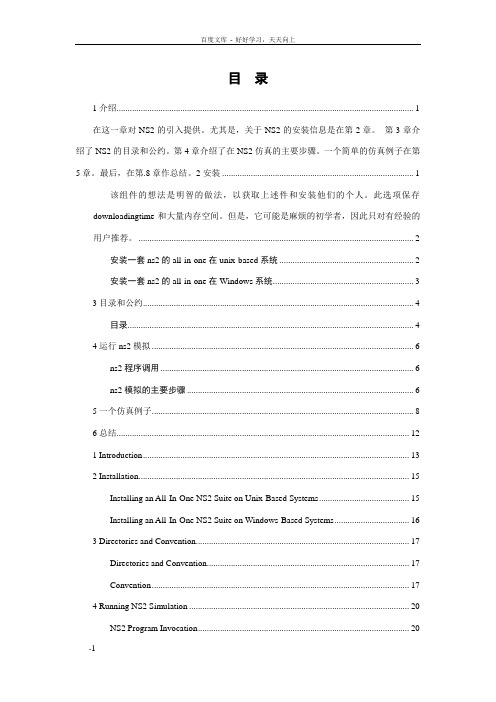
目录1介绍 (1)在这一章对NS2的引入提供。
尤其是,关于NS2的安装信息是在第2章。
第3章介绍了NS2的目录和公约。
第4章介绍了在NS2仿真的主要步骤。
一个简单的仿真例子在第5章。
最后,在第.8章作总结。
2安装 (1)该组件的想法是明智的做法,以获取上述件和安装他们的个人。
此选项保存downloadingtime和大量内存空间。
但是,它可能是麻烦的初学者,因此只对有经验的用户推荐。
(2)安装一套ns2的all-in-one在unix-based系统 (2)安装一套ns2的all-in-one在Windows系统 (3)3目录和公约 (4)目录 (4)4运行ns2模拟 (6)ns2程序调用 (6)ns2模拟的主要步骤 (6)5一个仿真例子 (8)6总结 (12)1 Introduction (13)2 Installation (15)Installing an All-In-One NS2 Suite on Unix-Based Systems (15)Installing an All-In-One NS2 Suite on Windows-Based Systems (16)3 Directories and Convention (17)Directories and Convention (17)Convention (17)4 Running NS2 Simulation (20)NS2 Program Invocation (20)Main NS2 Simulation Steps (20)5 A Simulation Example (22)6 Summary (27)1介绍网络模拟器(一般叫作NS2)的版本,是证明了有用在学习通讯网络的动态本质的一个事件驱动的模仿工具。
模仿架线并且无线网络作用和协议(即寻址算法,TCP,UDP)使用NS2,可以完成。
一般来说,NS2提供用户以指定这样网络协议和模仿他们对应的行为方式。
外文参考文献译文及原文
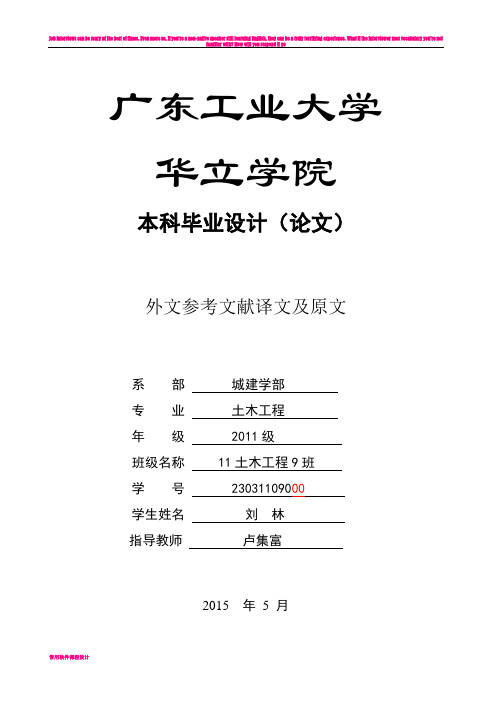
广东工业大学华立学院本科毕业设计(论文)外文参考文献译文及原文系部城建学部专业土木工程年级 2011级班级名称 11土木工程9班学号 23031109000学生姓名刘林指导教师卢集富2015 年5 月目录一、项目成本管理与控制 0二、Project Budget Monitor and Control (1)三、施工阶段承包商在控制施工成本方面所扮演的作用 (2)四、The Contractor's Role in Building Cost Reduction After Design (4)一、外文文献译文(1)项目成本管理与控制随着市场竞争的激烈性越来越大,在每一个项目中,进行成本控制越发重要。
本文论述了在施工阶段,项目经理如何成功地控制项目预算成本。
本文讨论了很多方法。
它表明,要取得成功,项目经理必须关注这些成功的方法。
1.简介调查显示,大多数项目会碰到超出预算的问……功控制预算成本。
2.项目控制和监测的概念和目的Erel and Raz (2000)指出项目控制周期包括测量成……原因以及决定纠偏措施并采取行动。
监控的目的就是纠偏措施的...标范围内。
3.建立一个有效的控制体系为了实现预算成本的目标,项目管理者需要建立一……被监测和控制是非常有帮助的。
项目成功与良好的沟通密...决( Diallo and Thuillier, 2005)。
4.成本费用的检测和控制4.1对检测的优先顺序进行排序在施工阶段,很多施工活动是基于原来的计……用完了。
第四,项目管理者应该检测高风险活动,高风险活动最有...重要(Cotterell and Hughes, 1995)。
4.2成本控制的方法一个项目的主要费用包括员工成本、材料成本以及工期延误的成本。
为了控制这些成本费用,项目管理者首先应该建立一个成本控制系统:a)为财务数据的管理和分析工作落实责任人员b)确保按照项目的结构来合理分配所有的……它的变化--在成本控制线上准确地记录所有恰...围、变更、进度、质量)相结合由于一个工程项目......虑时间价值影响后的结果。
外国书籍怎么写参考文献
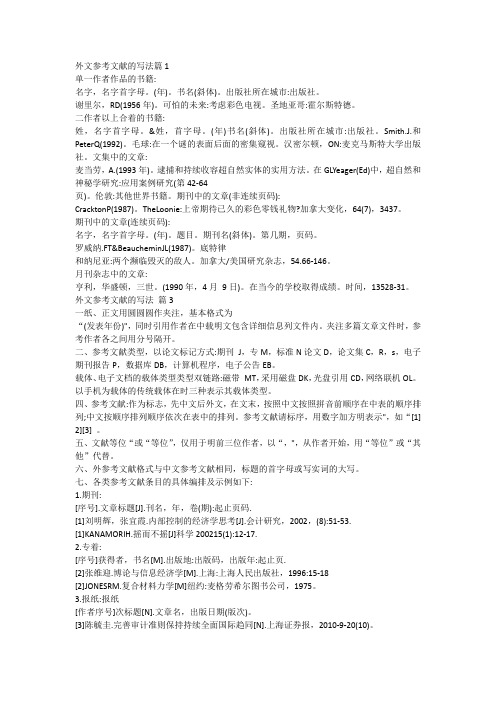
外文参考文献的写法篇1单一作者作品的书籍:名字,名字首字母。
(年)。
书名(斜体)。
出版社所在城市:出版社。
谢里尔,RD(1956年)。
可怕的未来:考虑彩色电视。
圣地亚哥:霍尔斯特德。
二作者以上合着的书籍:姓,名字首字母。
&姓,首字母。
(年)书名(斜体)。
出版社所在城市:出版社。
Smith.J.和PeterQ(1992)。
毛球:在一个谜的表面后面的密集窥视。
汉密尔顿,ON:麦克马斯特大学出版社。
文集中的文章:麦当劳,A.(1993年)。
逮捕和持续收容超自然实体的实用方法。
在GLYeager(Ed)中,超自然和神秘学研究:应用案例研究(第42-64页)。
伦敦:其他世界书籍。
期刊中的文章(非连续页码):CracktonP(1987)。
TheLoonie:上帝期待已久的彩色零钱礼物?加拿大变化,64(7),3437。
期刊中的文章(连续页码):名字,名字首字母。
(年)。
题目。
期刊名(斜体)。
第几期,页码。
罗威纳.FT&BeaucheminJL(1987)。
底特律和纳尼亚:两个濒临毁灭的敌人。
加拿大/美国研究杂志,54.66-146。
月刊杂志中的文章:亨利,华盛顿,三世。
(1990年,4月9日)。
在当今的学校取得成绩。
时间,13528-31。
外文参考文献的写法篇3一纸、正文用圆圆圆作夹注,基本格式为“(发表年份)",同时引用作者在中载明文包含详细信息列文件内。
夹注多篇文章文件时,参考作者各之间用分号隔开。
二、参考文献类型,以论文标记方式:期刊J,专M,标准N论文D,论文集C,R,s,电子期刊报告P,数据库DB,计算机程序,电子公告EB。
载体、电子文档的载体类型类型双链路:磁带MT,采用磁盘DK,光盘引用CD,网络联机OL。
以手机为载体的传统载体在时三种表示其载体类型。
四、参考文献:作为标志,先中文后外文,在文末,按照中文按照拼音前顺序在中表的顺序排列;中文按顺序排列顺序依次在表中的排列。
外文参考文献(带中文翻译)
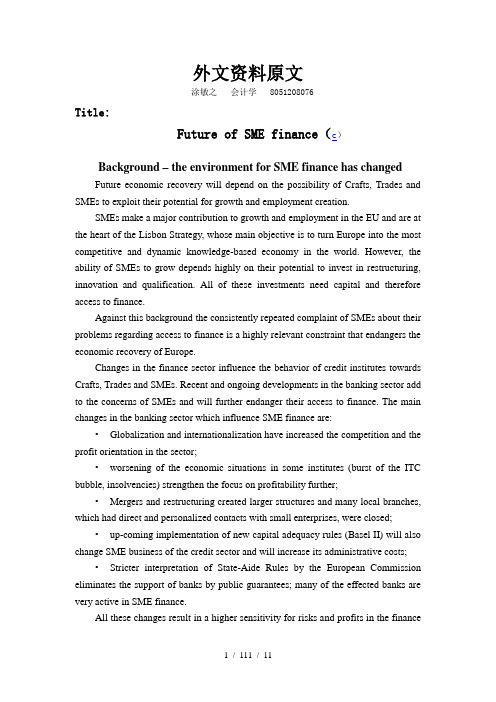
外文资料原文涂敏之会计学 8051208076Title:Future of SME finance(c)Background – the environment for SME finance has changedFuture economic recovery will depend on the possibility of Crafts, Trades and SMEs to exploit their potential for growth and employment creation.SMEs make a major contribution to growth and employment in the EU and are at the heart of the Lisbon Strategy, whose main objective is to turn Europe into the most competitive and dynamic knowledge-based economy in the world. However, the ability of SMEs to grow depends highly on their potential to invest in restructuring, innovation and qualification. All of these investments need capital and therefore access to finance.Against this background the consistently repeated complaint of SMEs about their problems regarding access to finance is a highly relevant constraint that endangers the economic recovery of Europe.Changes in the finance sector influence the behavior of credit institutes towards Crafts, Trades and SMEs. Recent and ongoing developments in the banking sector add to the concerns of SMEs and will further endanger their access to finance. The main changes in the banking sector which influence SME finance are:•Globalization and internationalization have increased the competition and the profit orientation in the sector;•worsening of the economic situations in some institutes (burst of the ITC bubble, insolvencies) strengthen the focus on profitability further;•Mergers and restructuring created larger structures and many local branches, which had direct and personalized contacts with small enterprises, were closed;•up-coming implementation of new capital adequacy rules (Basel II) will also change SME business of the credit sector and will increase its administrative costs;•Stricter interpretation of State-Aide Rules by the European Commission eliminates the support of banks by public guarantees; many of the effected banks are very active in SME finance.All these changes result in a higher sensitivity for risks and profits in the financesector.The changes in the finance sector affect the accessibility of SMEs to finance.Higher risk awareness in the credit sector, a stronger focus on profitability and the ongoing restructuring in the finance sector change the framework for SME finance and influence the accessibility of SMEs to finance. The most important changes are: •In order to make the higher risk awareness operational, the credit sector introduces new rating systems and instruments for credit scoring;•Risk assessment of SMEs by banks will force the enterprises to present more and better quality information on their businesses;•Banks will try to pass through their additional costs for implementing and running the new capital regulations (Basel II) to their business clients;•due to the increase of competition on interest rates, the bank sector demands more and higher fees for its services (administration of accounts, payments systems, etc.), which are not only additional costs for SMEs but also limit their liquidity;•Small enterprises will lose their personal relationship with decision-makers in local branches –the credit application process will become more formal and anonymous and will probably lose longer;•the credit sector will lose more and more i ts “public function” to provide access to finance for a wide range of economic actors, which it has in a number of countries, in order to support and facilitate economic growth; the profitability of lending becomes the main focus of private credit institutions.All of these developments will make access to finance for SMEs even more difficult and / or will increase the cost of external finance. Business start-ups and SMEs, which want to enter new markets, may especially suffer from shortages regarding finance. A European Code of Conduct between Banks and SMEs would have allowed at least more transparency in the relations between Banks and SMEs and UEAPME regrets that the bank sector was not able to agree on such a commitment.Towards an encompassing policy approach to improve the access of Crafts, Trades and SMEs to financeAll analyses show that credits and loans will stay the main source of finance for the SME sector in Europe. Access to finance was always a main concern for SMEs, but the recent developments in the finance sector worsen the situation even more.Shortage of finance is already a relevant factor, which hinders economic recovery in Europe. Many SMEs are not able to finance their needs for investment.Therefore, UEAPME expects the new European Commission and the new European Parliament to strengthen their efforts to improve the framework conditions for SME finance. Europe’s Crafts, Trades and SMEs ask for an encompassing policy approach, which includes not only the conditions for SMEs’ access to l ending, but will also strengthen their capacity for internal finance and their access to external risk capital.From UEAPME’s point of view such an encompassing approach should be based on three guiding principles:•Risk-sharing between private investors, financial institutes, SMEs and public sector;•Increase of transparency of SMEs towards their external investors and lenders;•improving the regulatory environment for SME finance.Based on these principles and against the background of the changing environment for SME finance, UEAPME proposes policy measures in the following areas:1. New Capital Requirement Directive: SME friendly implementation of Basel IIDue to intensive lobbying activities, UEAPME, together with other Business Associations in Europe, has achieved some improvements in favour of SMEs regarding the new Basel Agreement on regulatory capital (Basel II). The final agreement from the Basel Committee contains a much more realistic approach toward the real risk situation of SME lending for the finance market and will allow the necessary room for adaptations, which respect the different regional traditions and institutional structures.However, the new regulatory system will influence the relations between Banks and SMEs and it will depend very much on the way it will be implemented into European law, whether Basel II becomes burdensome for SMEs and if it will reduce access to finance for them.The new Capital Accord form the Basel Committee gives the financial market authorities and herewith the European Institutions, a lot of flexibility. In about 70 areas they have room to adapt the Accord to their specific needs when implementing itinto EU law. Some of them will have important effects on the costs and the accessibility of finance for SMEs.UEAPME expects therefore from the new European Commission and the new European Parliament:•The implementation of the new Capital Requirement Directive will be costly for the Finance Sector (up to 30 Billion Euro till 2006) and its clients will have to pay for it. Therefore, the implementation – especially for smaller banks, which are often very active in SME finance –has to be carried out with as little administrative burdensome as possible (reporting obligations, statistics, etc.).•The European Regulators must recognize traditional instruments for collaterals (guarantees, etc.) as far as possible.•The European Commission and later the Member States should take over the recommendations from the European Parliament with regard to granularity, access to retail portfolio, maturity, partial use, adaptation of thresholds, etc., which will ease the burden on SME finance.2. SMEs need transparent rating proceduresDue to higher risk awareness of the finance sector and the needs of Basel II, many SMEs will be confronted for the first time with internal rating procedures or credit scoring systems by their banks. The bank will require more and better quality information from their clients and will assess them in a new way. Both up-coming developments are already causing increasing uncertainty amongst SMEs.In order to reduce this uncertainty and to allow SMEs to understand the principles of the new risk assessment, UEAPME demands transparent rating procedures –rating procedures may not become a “Black Box” for SMEs: •The bank should communicate the relevant criteria affecting the rating of SMEs.•The bank should inform SMEs about its assessment in order to allow SMEs to improve.The negotiations on a European Code of Conduct between Banks and SMEs , which would have included a self-commitment for transparent rating procedures by Banks, failed. Therefore, UEAPME expects from the new European Commission and the new European Parliament support for:•binding rules in the framework of the new Capital Adequacy Directive,which ensure the transparency of rating procedures and credit scoring systems for SMEs;•Elaboration of national Codes of Conduct in order to improve the relations between Banks and SMEs and to support the adaptation of SMEs to the new financial environment.3. SMEs need an extension of credit guarantee systems with a special focus on Micro-LendingBusiness start-ups, the transfer of businesses and innovative fast growth SMEs also depended in the past very often on public support to get access to finance. Increasing risk awareness by banks and the stricter interpretation of State Aid Rules will further increase the need for public support.Already now, there are credit guarantee schemes in many countries on the limit of their capacity and too many investment projects cannot be realized by SMEs.Experiences show that Public money, spent for supporting credit guarantees systems, is a very efficient instrument and has a much higher multiplying effect than other instruments. One Euro form the European Investment Funds can stimulate 30 Euro investments in SMEs (for venture capital funds the relation is only 1:2).Therefore, UEAPME expects the new European Commission and the new European Parliament to support:•The extension of funds for national credit guarantees schemes in the framework of the new Multi-Annual Programmed for Enterprises;•The development of new instruments for securitizations of SME portfolios;•The recognition of existing and well functioning credit guarantees schemes as collateral;•More flexibility within the European Instruments, because of national differences in the situation of SME finance;•The development of credit guarantees schemes in the new Member States;•The development of an SBIC-like scheme in the Member States to close the equity gap (0.2 – 2.5 Mio Euro, according to the expert meeting on PACE on April 27 in Luxemburg).•the development of a financial support scheme to encourage the internalizations of SMEs (currently there is no scheme available at EU level: termination of JOP, fading out of JEV).4. SMEs need company and income taxation systems, whichstrengthen their capacity for self-financingMany EU Member States have company and income taxation systems with negative incentives to build-up capital within the company by re-investing their profits. This is especially true for companies, which have to pay income taxes. Already in the past tax-regimes was one of the reasons for the higher dependence of Europe’s SMEs on bank lending. In future, the result of rating w ill also depend on the amount of capital in the company; the high dependence on lending will influence the access to lending. This is a vicious cycle, which has to be broken.Even though company and income taxation falls under the competence of Member States, UEAPME asks the new European Commission and the new European Parliament to publicly support tax-reforms, which will strengthen the capacity of Crafts, Trades and SME for self-financing. Thereby, a special focus on non-corporate companies is needed.5. Risk Capital – equity financingExternal equity financing does not have a real tradition in the SME sector. On the one hand, small enterprises and family business in general have traditionally not been very open towards external equity financing and are not used to informing transparently about their business.On the other hand, many investors of venture capital and similar forms of equity finance are very reluctant regarding investing their funds in smaller companies, which is more costly than investing bigger amounts in larger companies. Furthermore it is much more difficult to set out of such investments in smaller companies.Even though equity financing will never become the main source of financing for SMEs, it is an important instrument for highly innovative start-ups and fast growing companies and it has therefore to be further developed. UEAPME sees three pillars for such an approach where policy support is needed:Availability of venture capital•The Member States should review their taxation systems in order to create incentives to invest private money in all forms of venture capital.•Guarantee instruments for equity financing should be further developed.Improve the conditions for investing venture capital into SMEs•The development of secondary markets for venture capital investments in SMEs should be supported.•Accounting Standards for SMEs should be revised in order to easetransparent exchange of information between investor and owner-manager.Owner-managers must become more aware about the need for transparency towards investors•SME owners will have to realise that in future access to external finance (venture capital or lending) will depend much more on a transparent and open exchange of information about the situation and the perspectives of their companies.•In order to fulfil the new needs for transparency, SMEs will have to use new information instruments (business plans, financial reporting, etc.) and new management instruments (risk-management, financial management, etc.).外文资料翻译涂敏之会计学 8051208076题目:未来的中小企业融资背景:中小企业融资已经改变未来的经济复苏将取决于能否工艺品,贸易和中小企业利用其潜在的增长和创造就业。
毕业论文外文参考文献

毕业论文外文参考文献毕业论文外文参考文献在撰写毕业论文时,外文参考文献的使用是非常重要的。
通过引用外文参考文献,我们可以展示对于研究领域的深入了解,并且可以为自己的研究提供更广阔的视野。
本文将探讨毕业论文中外文参考文献的使用方法和注意事项。
首先,选择合适的外文参考文献至关重要。
在选择外文参考文献时,我们应该确保其与自己的研究主题相关,并且具有一定的权威性。
我们可以通过查阅学术数据库、期刊和书籍来寻找合适的外文参考文献。
此外,我们还可以通过与导师和同行的讨论,了解他们在该领域的推荐文献。
其次,引用外文参考文献需要遵循一定的规范。
在引用外文参考文献时,我们应该使用标准的引用格式,例如APA、MLA等。
这些引用格式可以确保我们的引用符合学术规范,并且能够提供足够的信息以供读者查阅。
在引用外文参考文献时,我们应该包括作者姓名、文章标题、期刊名称、出版日期等基本信息,并且在文中标注相应的引用序号。
此外,我们在使用外文参考文献时,应该注重其翻译的准确性。
有时候,我们可能需要将外文参考文献翻译成中文,以便读者更好地理解。
在进行翻译时,我们应该确保翻译的准确性,并且尽量保持原文的语义和结构。
如果我们在翻译过程中遇到困难,可以寻求专业翻译人员的帮助,以确保翻译的质量。
此外,我们还需要注意外文参考文献的版权问题。
在使用外文参考文献时,我们应该尊重原作者的版权,并且遵守相关的法律法规。
如果我们需要引用外文参考文献的大段文字或图表,我们应该获得原作者的许可,并在文中进行相应的标注。
这样可以保证我们的研究不侵犯他人的知识产权,并且能够提高我们的学术声誉。
最后,我们还应该注意外文参考文献的可信度。
在使用外文参考文献时,我们应该确保其来源可靠,并且经过了同行评审。
我们可以通过查看期刊的影响因子、作者的学术背景和引用次数等指标来评估外文参考文献的可信度。
此外,我们还可以通过查阅其他相关研究的引用文献,来了解该外文参考文献在该领域的重要性和影响力。
毕业设计外文参考文献

[1] 王起江,洪杰.超超临界电站锅炉用新型管材的研制[J].宝钢技术,2008(5):44-53.[2] 王起江,邹凤鸣.T91高压锅炉管的研制与应用[J].发电设备,2005 (1):43-47.[3] Fujio Abe.Bainitic and martensitic creep-resistant steels[J].Solid State andMaterials Science,2004,8:305-311.[4] 马明编译.美国新的超临界机组考虑使用T/P92的原因[J].电力建设,2006,27(11):79-80.[5] 戴平.国产P91钢管道存在的问题及其解决[J].广东电力,2008,21(8):67-69.[6] 田党.关于难变形钢和合金管坯的二辊斜轧穿孔问题[J].钢铁,1998,33(1):33-36.[7] P J Ennis,A Czyrska-Filemonowicz.Recent advances in creep-resistant steelsfor power plant applications [J].Sādhanā,2003,28:709–730.[8] 刘立民,朱洪,刘志国.法国T91、P91钢管性能评定[J].电站系统工程,2002,18(1):63-64.[9] 彭孙鸿.T91钢管在我国的应用前景[J].宝钢技术,1997,6:48-50.[10] H.C. Furtado,L.H. de Almeida,I. Le May.Precipitation in 9Cr–1Mo steel aftercreep deformation[J].Materials Characterization,2007,58:72–77.[11] 蒯春光,彭志方.T/P91钢在450-1200℃区间各相元素的分配特征及相稳定性[J].金属学报,2008,44(8):897-900.[12] 孙智,董小文,张绪平,等.奥氏体化温度对9Cr-1Mo-V-Nb钢组织与性能的影响[J].金属热处理,2001,26(8):12-14.[13] 刘靖,周立新,傅晨光,等.电站锅炉用T91钢热穿孔性能的研究[J].钢管,2002,31(5):9-11.[14] 彭孙鸿,尤夙志,姜明娟,等.热穿孔温度对T91持久强度的影响[J].特殊钢,2001,22(2):10-12.[15] 崔光珠,朱伏先,高德福,等.T91钢高温变形特性研究[J].塑性工程学报,1999,6(2):13-16.[16] 余勇,周晓岚,赵志毅,等.T91变形抗力模型建立及理论轧制压力计算[J].宝钢技术,2006(3):31-34.[17] Polcik P,Sailer T,Blum W,et al.On the microstructural development of thetempered martensitic Cr-steel P91 during long-term creep[J].Materials Science and Engineering,1999,260:252-259.[18] Orlová A,Buršík J,Kucharová K,et al.Microstructural development duringhigh temperature creep of 9% Cr steel[J].Materials Science and Engineering,1998,254:39-48.[19] Sasaki,Terufumi,Kobayashi,et al.Production and properties of seamlessmodified 9Cr-1Mo steel boiler tubes[R].Kaw asaki Steel Technical Report,1991,25(4):78-87.[20] Bendick W,Vaillant JC,Vandenberghe B,et al.Properties and workability ofnew creep strength enhanced steels as known grades 23, 24, 911 and 92[J].International Journal of Pressure Vessels and Piping,2004,476:25-29.[21] 刘江南,王正品,束国刚,等.P91钢的形变强化行为[J].金属热处理,2009,34(1):28-32.[22] Tőkei Z S,Viefhaus H,Grabke H J.Initial stages of oxidation of a9CrMoV-steel: role of segregation and martensite laths[J].Applied Surface Science,2000,165:23-33.[23] Rajendran P S,Sankar P,Khatak H S.Cyclic oxidation of P91 at 1073, 1123 and1173K[J].High Temperature Materials and Processes,2004,23(3):195-204.[24] Ahmed Shibli,Fred Starr.Some aspects of plant and research experience in theuse of new high strength martensitic steel P91[J].International Journal of Pressure Vessels and Piping,2007,84:114-122.[25] J.C. Vaillant,B. Vandenberghe,B. Hahn,et al.T/P23, 24, 911 and 92: Newgrades for advanced coal-fired power plants—Properties and experience [J].International Journal of Pressure Vessels and Piping,2008,85:38-46.[26] Brett SJ.The creep strength of weak thick section modified 9Crforgings[C].Proceedings of Baltica,2001,1:39-45.[27] U.Gampe,P.Seliger.Creep crack growth testing of P91 and P22bends[J].International Journal of Pressure Vessels and Piping,2001,78:859-864.[28] L.Kunz,P.Lukáš.High temperature fatigure and cyclic creep of P91steel[J].European Structural Integrity Society,2002,29:37-44.[29] B.Fournier,M.Sauzay,C.Caës,et al.Creep-fatigue-oxidation interactions ina 9Cr-1Mo martensitic steel[J].International Journal of Pressure Vessels andPiping,2008,85:478-485.[30] 刘洪杰.电站锅炉用P91钢蠕变/疲劳交互作用的试验研究[J].动力工程,2007,27(6):990-995.[31] LIU Jiang-nan,JIE Wang-qi.Application of improved vacuum degassingtechnique to refinement of heat resistant steel P91[J].Trans. Nonferrous Met.Soc. China,2005,15:291-294.[32] 苏俊,张铮,李进.P91高压锅炉管的开发[J].钢管,2008,37(4):33-37.[33] 郭元蓉,吴红.P91无缝钢管国产化研究进展[J].钢管,2008,37(1):22-27.[34] 王起江,邹凤鸣,张瑞,等.宝钢T91高压锅炉管性能试验与研究[J].宝钢技术,2003,(4):46-50.[35] Miyata K,Sawaragi Y.Effect of Mo and W on the phase stability of precipitatesin low Cr heat resistant steels[J].ISIJ,2001,41:281-289.[36] Wachter O,Ennis PJ.Investigation of the properties of the 9% Cr steel of thetype 9Cr-0.5Mo-1.8W-V-Nb with respect to its application as a pipework and boiler steel operation at elevated temperatures[D].Germany,1995.[37] Hättestrand M,Andrén H O.Evaluation of particle size distribution in a 9% Crsteel using EFTEM[J].Micron,2001,32:789-797.[38] Sklenicka V,Kucharova K,Svoboda M,et al.Long-term creep behavior of9-12%Cr power plant steels [J].Mater. Character,2003,51:35-48.[39] Strang A,Foldyna V,Lenert J,et al.Prediction of the long-term creep ruptureproperties of 9-12Cr power plant steels [C].Proceedings of the 6th International Charles Parsons Turbine Conference,Dublin,2003,427-441.[40] Kimura K,Kushima H,Sawaka K.Long-term creep strength prediction of highCr ferritic creep resistant steels based on degradation mechanisms[C].Proceedings of the 6th International Charles Parsons Turbine Conference,Dublin,2003,444-456.[41] 高巍,刘江南,王正品,等.P92钢塑性变形行为[J].西安工业大学学报,2008,28(4):356-359.[42] 田党,张根良,卜玉钦.二辊斜轧穿孔时高合金钢的变形分布和分层缺陷形成机制[J].钢铁,1995,30(1):40-45.[43] 刘新生,赵定国,崔成业.冷轧薄板中分层现象的研究[J].钢铁,2008,43(5):40-43.[44] 崔风平,赵乾,唐愈.铸坯内部缺陷对钢板分层形成的影响[J].中国冶金,2008,18(2):14-18.[45] 唐生斌.板材分层缺陷产生原因分析[J].连铸,2003,4:32-34.[46] 洪小玲,肖荣仁,李端来.GH3030合金锻坯裂纹分析[J].钢铁研究,2002,128(5):11-12.[47] S.A.Sharadzenidze,E.A.Svetlitskii.High Quality Seamless Tubes[J]. Metallurg,1968,11:38-39.[48] 王建文.27SiMn钢管表面龟裂原因分析[J].湖南冶金,2000,5:25-26.[49] 任建国,祁晓英,马学军,等.低合金钢热轧缺陷分析[J].沈阳工业学院学报,1996,15(3):35-37.[50] 卢居桂,安自亮,刘钰.夹杂物引起的石油套管缺陷分析[J].天津冶金,2002,106(1):27-29.[51] 田党.关于锥形辊穿孔机轧辊转速对毛管分层缺陷影响的讨论[J].钢管,2006,35(4):12-16.[52] 王永吉,陈大国,王世英,等.二辊斜轧穿孔轧辊转速对高合金钢毛管质量的影响[J].钢铁,1985,20(2):25-30.[53] 严智.高温合金穿孔工艺的研究[J].特钢技术,1994,2:27-31.[54] 田党.高温合金无缝管材的研制与生产[J].钢管,2002,31(3):1-6.[55] 田党.关于毛管分层缺陷的试验研究[J].轧钢,1997,6:7-10.[56] 田党.高温合金管坯在二辊斜轧穿孔机上的穿孔实践[J].天津冶金,1996,4:25-28.[57] 田党.毛管分层缺陷形成过程的观察和分析[J].天津冶金,1996,1:24-26.[58] 田党.高温合金毛管分层缺陷形成的过程[J].钢管,1992,1:19-22.[59] 卢于逑,王先进.二辊斜轧穿孔中心金属断裂机理和穿孔变形工艺实质[J].钢铁,1980,6:7-15.[60] 卢于逑,王先进.二辊斜轧穿孔圆坯断面的变形分布[J].金属学报,1980,4:470-479.[61] 田党,张根良,卜玉钦.二辊斜轧穿孔时高温合金钢圆坯的变形分布及分层形成机制[J].钢铁,1995,30(1):40-46.[62] 田党,李群.关于锥形辊穿孔机的穿孔原理及应用问题的讨论[J].钢管,2003,32(6):1-4.[63] 赵咏秋,吴秀丽,陈菊芳.0Cr18Ni9Ti热轧荒管分层内裂原因分析[J].物理测试,1999,2:33-35.[64] 张存信,冯晓庭,项炳和,等.不锈钢无缝管加工过程中断裂原因简析[J].钢管,2008,37(3):38-42.[65] 袁桂林,苏殿荣.GCr15钢管环状层裂在二辊斜轧穿孔过程中的发生和发展[J].钢管,1983,3:15-18.[66] 张世文,刘仓理,李庆忠,等.初始应力状态对材料层裂破坏特性影响研究[J].力学学报,2008,40(4):535-542.[67] 侯凤桐.日本住友金属公司新开发的菌式穿孔机[J].钢管技术,1985,2:57-59.[68] Chihiro HAYASHI,Tomio YAMAKAWA.Influences of Feed and Cross Angleon Inside Bore and Lamination Defects in Rotary Piercing for Materials with Poor Hot Workability [J].ISIJ International,1997,37(2):153-160.[69] 嵇国金,彭颖红,阮雪榆.有关金属体积成形中的韧性断裂准则[J].金属成形工艺,1998,16(4):36-37.[70] 郭达人编译.金属材料的断裂及其断口分析[J].国外金属热处理,1996,17(4):25-31.[71] 黄建科,董湘怀.金属成形中韧性断裂准则的细观损伤力学研究进展[J].上海交通大学学报,2006,40(10):1748-1753.[72] Oyane M,Sota T,Okintoto K,et al.Criteria for ductile fractures and theirapplications[J].J Mech Work Tech,1980,4:65-81.[73] 郑长卿,张克实,周利.金属韧性破坏的细观力学及其应用研究[M].北京:国防工业出版社,1995,28-32.[74] Venugopal Rao A,Ramakrishnan N,Krishna Kumar R.A comparativeevaluation of the theoretical failure criteria for workability in cold forging[J].Journal of Materials Processing Technology,2003,142(1):29-42.[75] Komori Kazutake.Effect of ductile fracture criteria on chevron crack formationand evolution in drawing[J].International Journal of Mechanical Sciences,2003,45(1):141-160.[76] Ozturk Fahrettin,Lee Daeyong.Analysis of forming limits using ductile fracturecriteria[J].Journal of Materials Processing Technology,2004,147(3):397-404.[77] Jeong Kim,Sung-Jong Kang,Beom-Soo Kang.A prediction of bursting failurein tube hydroforming processes based on ductile fracture criterion[J].Int J Adv Manuf Technol,2003,22:357-362.[78] 虞松,陈军,阮雪榆.韧性断裂准则的试验与理论研究[J].中国机械工程,2006,17(19):2049-2052.[79] 胡庆安,程侠,邰卫华.金属材料断裂预测损伤破坏准则的应用[J].长安大学学报,2007,27(4):100-102.[80] 俞树荣,严志刚,曹睿,等.有限元软件模拟裂纹扩展的方法探讨[J].甘肃科学学报,2003,15(4):15-21.[81] 陈乃超,田冠玉,郑博.12Cr1MoV短期高温冲击断裂韧性及其参数的研究[J].上海电力学院学报,2008,24(2):178-181.[82] Ken-ichiro Mori,Hidenori Yoshimura,Kozo Osakada.Simplified three-dimensional simulation of rotary piercing of seamless pipe by rigid-plastic finite-element method[J].Journal of Materials Processing Technology,1998,80-81:700-706.[83] Y van Chastel,Aliou Diop,Silvio Fanini,et al.Finite Element Modeling ofTube Piercing and Creation of a Crack[J].Int J Mater Form,2008,Suppl 1:355-358.[84] Hyoung Wook Lee,Geun An Lee,Eung Kim,et al.Prediction of plug tipposition in rotary tube piercing mill using simulation and experiment[J].International Journal of Modern Physics B,2008,22(31-32):5787-5792.[85] S Fanini,A Ghiotti,S Bruschi.Evaluation of Fracture Initiation in theMannesmann Piercing Process[C].The 10th ESAFORM Conference on Material Forming,2007,709-714.[86] Saurabh Dwivedi,Samuel H,Huang Jun Shi,et al.Yield prediction for seamlesstubing processes: a computational intelligence approach[J].Int Adv Manuf Technol,2008,37:314-322.[87] Elisabetta Ceretti,Claudio Glaudio,Aldo Attanasio.3D Simulation andValidation of Tube Piercing Process[C].NUMIFORM 07 Materials and Design: Modling, Simulation and Applications,2007,413-418.[88] Kazutake Komori.Simulation of Mannesmann piercing process by thethree-dimensional rigid-plastic finite-element method[J].International Journal of Mechanical Sciences,2005,47:1838-1853.[89] Hayashi C,Yamakawa T.Influence of feed and cross angle on rotary forgingeffects and redundant shear deformation in rotary piercing process[J].ISIJ International,1997,37:146-152.[90] 曾幼宗.斜轧穿孔工艺的有限元分析[J].钢管,2004,33(3):51-53.[91] 双远华,赖明道,张中元.斜轧穿孔过程金属流动的有限元模拟[J].机械工程学报,2004,40(3):140-144.[92] 双远华,赖明道,张中元.钢管斜轧过程应力应变与温度耦合模拟分析[J].锻压技术,2003(6):36-40.[93] 李胜衹,陈大宏,孙中建,等.二辊斜轧穿孔时圆管坯的变形与应力分布及其发展[J].钢铁研究学报,2000,12(5):26-30.[94] A Ghiotti,S Fanini,S Bruschi,et al.Modeling of the Mannesmanneffect[J].CIRP Annals-Manufacturing Technology,2009,58:255-258.[95] E.I. Panov.Shear Stresses and Their Dependence on Different ProcessParameters in The Helical Rolling of Solid Semifinished Products[J].Metallurgist,2005,49(7-8):280-292.[96] E.I. Panov.Certain Aspects of The Stress-Strain State of Semifinished Productsin Helical Rolling[J].Metallurgist,2003,47(11-12):499-505.[97] E.I. Panov.Effect of thrust and tension on the radial stresses in helical rolling[J].Metallurg,2004,4:50-57.[98] Z. Pater,J. Kazanecki,J. Bartnicki.Three dimensional thermo-mechanicalsimulation of the tube forming process in Diescher’s mill [J].Journal of Materials Processing Technology,2006,177:167-170.[99] 双远华,陈惠琴,赖明道.斜轧管材生产中内部组织有限元模拟和预测[J].中国有色金属学报,2001,11(2):238-242.[100] 双远华,张中元,赖明道.热轧穿孔内部组织控轧的工业性试验研究[J].钢铁,2002,37(6):42-47.[101] J C Prince,R Maroño,F León.Thermomechanical analysis of a piercing mandrel for the production of seamless steel tubes[J].J. Process Mechanical Engineering,2003,217:337-344.[102] W.A.Khudheyer,D.C.Barton,T.Z.Blazynski.A comparison between macroshear redundancy and loading effects in 2- and 3-roll rotary tube cone piercers[J].Journal of Materials Processing Technology,1997,65:191-202.[103] A.N.Nikulin,V.V. Streletskii.Deformation of continuous cast metal during rotary rolling[J].Metallurgist,2005,49(3-4):97-101.[104] Kazutake Komori,Kouta Mizuno.Study on plastic deformation in cone-type rotary piercing process using model piercing mill for modeling clay[J].Journal of Materials Processing Technology,2009,209:4994-5001.[105] 李连诗.钢管塑性变形原理(上册)[M],北京:冶金工业出版社,1985:178-185.[106] 卢于逑.斜轧穿孔过程中应力和变形的分布和中心金属断裂机构的某些特点分析[D].北京:北京钢铁学院,1963.[107] 卢于逑,王先进.二辊斜轧穿孔时圆坯断面的变形分布和发展[J].金属学报,1980,16(4):470-479.[108] 严泽生.现代热轧无缝钢管生产[M].北京:冶金工业出版社,2009:175-195.[109] Takuda H,Mori K,Hatta N.The application of some criteria for ductile fracture to the prediction of the forming limit of sheet metals[J].J Mater Process Technol,1999,95:116-121.[110] Takuda H,Mori K,Fujimoto H,et al.Prediction of the forming limit in bore-expanding of sheet metals using ductile fracture criteria[J].J Mater Process Technol,1999,92-93:433-438.[111] Mori K,Takuda H.Prediction of forming limit in deep drawing of finite element simulation and criterion for ductile fracture[J].Transaction of NAMRI/SME XXIV,1996,143-148.[112] Takuda H,Mori K,Takakura N,et al.Finite element analysis of limit strains in biaxial stretching of sheet metals allowing for ductile fracture[J].Int J Mech Sci,2000,42:785-798.。
外文参考文献格式举例
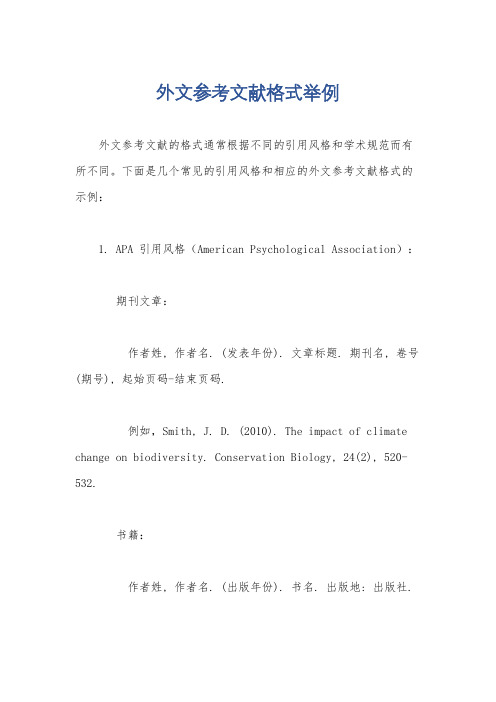
外文参考文献格式举例外文参考文献的格式通常根据不同的引用风格和学术规范而有所不同。
下面是几个常见的引用风格和相应的外文参考文献格式的示例:1. APA 引用风格(American Psychological Association):期刊文章:作者姓, 作者名. (发表年份). 文章标题. 期刊名, 卷号(期号), 起始页码-结束页码.例如,Smith, J. D. (2010). The impact of climate change on biodiversity. Conservation Biology, 24(2), 520-532.书籍:作者姓, 作者名. (出版年份). 书名. 出版地: 出版社.例如,Johnson, M. (2015). Mind and Matter: A New Understanding of Consciousness. New York, NY: Harper Collins.2. MLA 引用风格(Modern Language Association):期刊文章:作者名, 作者姓. "文章标题." 期刊名, 卷号.期号 (发表年份): 起始页码-结束页码.例如,Smith, John. "The Impact of Climate Change on Biodiversity." Conservation Biology, vol. 24, no. 2, 2010, pp. 520-532.书籍:作者姓, 作者名. 书名. 出版地: 出版社, 出版年份.例如,Johnson, Mark. Mind and Matter: A New Understanding of Consciousness. New York, Harper Collins, 2015.3. Chicago 引用风格:期刊文章:作者姓, 作者名. "文章标题." 期刊名卷号, no. 期号(发表年份): 起始页码-结束页码.例如,Smith, John. "The Impact of Climate Change on Biodiversity." Conservation Biology 24, no. 2 (2010): 520-532.书籍:作者姓, 作者名. 书名. 出版地: 出版社, 出版年份.例如,Johnson, Mark. Mind and Matter: A New Understanding of Consciousness. New York: Harper Collins, 2015.请注意,以上只是引用风格的示例,实际引用时,需要根据具体的情况,如作者数量、出版地点等进行相应的调整。
2024年外文参考文献格式要求

D.专著中析出的文献
〔序号〕 析出责任者.析出题名.见(英文用In):专著责任者.书名.出版地:出版者,出版年:起止页码.
〔12〕罗云.安全科学理论体系的`发展及趋势探讨.见:白春华,何学秋,吴宗之.21世纪安全科学与技术的发展趋势.北京:科学出版社,2000:1-5.
2024年外文参考文献格式要求
外文参考文献格式要求 篇1
单一作者著作的书籍:
姓,名字首字母.(年). 书名(斜体). 出版社所在城市:出版社.
Sheril, R. D. (1956). The terrifying future: Contemplating color television. San Diego: Halstead.
②磁带数据库[DB/MT]
③光盘图书[M/CD]
④磁盘软件[CP/DK]
⑤网上期刊[J/OL]
⑥网上电子公告[EB/OL]
期刊论文
[1]周庆荣,张泽廷,朱美文,等.固体溶质在含夹带剂超临界流体中的.溶解度[J].化工学报,1995,46(3):317 323
[2]Dobbs J M, Wong J M. Modification of supercritical fluid phasebehavior using polor coselvent[J]. Ind Eng Chem Res, 1987,26:56
B.专著
〔序号〕 主要责任者.文献题名〔M〕.出版地:出版者,出版年:页码.
〔3〕 刘国钧,郑如斯.中国书的故事〔M〕.北京:中国青年出版社,1979:115.
参考文献 英文
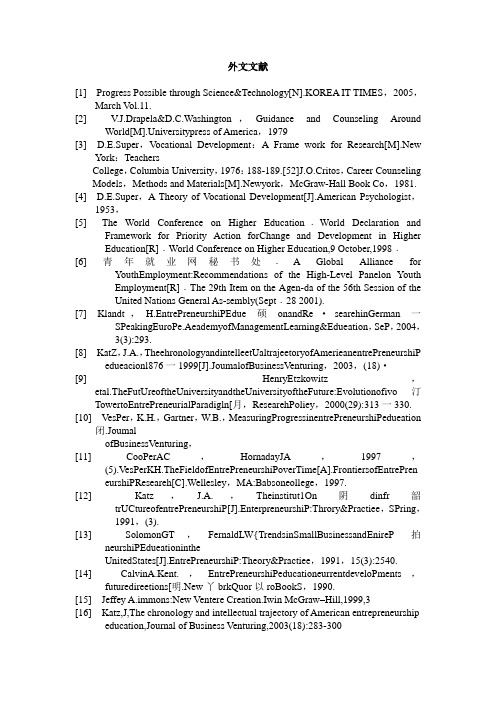
外文文献[1] Progress Possible through Science&Technology[N].KOREA IT TIMES,2005,March V ol.11.[2] V.J.Drapela&D.C.Washington,Guidance and Counseling AroundWorld[M].Universitypress of America,1979[3] D.E.Super,V ocational Development:A Frame work for Research[M].NewYork:TeachersCollege,Columbia University,1976:188-189.[52]J.O.Critos,Career Counseling Models,Methods and Materials[M].Newyork,McGraw-Hall Book Co,1981.[4] D.E.Super,A Theory of V ocational Development[J].American Psychologist,1953,[5] The World Conference on Higher Education﹒World Declaration andFramework for Priority Action forChange and Development in Higher Education[R]﹒World Conference on Higher Education,9 October,1998﹒[6] 青年就业网秘书处﹒ A Global Alliance forYouthEmployment:Recommendations of the High-Level Panelon YouthEmployment[R]﹒The 29th Item on the Agen-da of the 56th Session of theUnited Nations General As-sembly(Sept﹒28 2001).[7] Klandt,H.EntrePreneurshiPEdue硕onandRe·searehinGerman一SPeakingEuroPe.AeademyofManagementLearning&Edueation,SeP,2004,3(3):293.[8] KatZ,J.A.,TheehronologyandintelleetUaltrajeetoryofAmerieanentrePreneurshiPedueacionl876一1999[J].JoumalofBusinessVenturing,2003,(18)·[9] HenryEtzkowitz,etal.TheFutUreoftheUniversityandtheUniversityoftheFuture:Evolutionofivo汀TowertoEntrePreneurialParadigln[月,ResearehPoliey,2000(29):313一330. [10] VesPer,K.H.,Gartner,W.B.,MeasuringProgressinentrePreneurshiPedueation闭.JoumalofBusinessVenturing,[11] CooPerAC,HornadayJA,1997,(5).VesPerKH.TheFieldofEntrePreneurshiPoverTime[A].FrontiersofEntrePreneurshiPReseareh[C].Wellesley,MA:Babsoneollege,1997.[12] Katz,J.A.,Theinstitut1On阴dinfr韶trUCtureofentrePreneurshiP[J].EnterpreneurshiP:Throry&Practiee,SPring,1991,(3).[13] SolomonGT,FernaldLW{TrendsinSmallBusinessandEnireP拍neurshiPEdueationintheUnitedStates[J].EntrePreneurshiP:Theory&Practiee,1991,15(3):2540. [14] CalvinA.Kent.,EntrePreneurshiPeducationeurrentdeveloPments,futuredireetions[明.New丫brkQuor以roBookS,1990.[15] Jeffey A.immons:New Ventere Creation.Iwin McGraw–Hill,1999,3[16] Katz,J,The chronology and intellectual trajectory of American entrepreneurshipeducation,Journal of Business Venturing,2003(18):283-300[17]Vesper,K.H.,Gartner,W.B.,1997.Measuingprogressinentrepreneurshipeducation.J.Bus.Ve[18] Aaron Koh.Towards Crica l Pedagogy:Creating’thingking Schools’inSinggaporein:Joural of Curriculum studies.Taylor&Francis ltd,2002 255-264 [19] Jan H.Van Driel,Nico Verloop etal.Teachers’craft knowledge and curriculuminnovationin higher engineering education.in:Higher Education 1997:105-122 [20] Lin,Nan,“SocialResourcesandInstrumentalAetion.”Soeia1S加etureAndNetworkAnalysis,editdbyPeterMarsden&NanLin,BeverlyHills,CA:SagePublieations,Ine,1982[21] Lin,Nan,“SoeialResoureesTheory.”,inEneyeloPediaofSoeiology,V olume4,EditedbyE.F.BorgattaandM.1.Borgatta,NewYork:Maemillan,1992[22] Burt,Ronald,StruetureHoles:TheSoeialStruetUreofComPetition,MA:HarvardUniversityPress,1992[23] GranovetterMark.ThestrengthofweakTies.〔J].AmerieaJoumalofSoeiology,1973,78[24] Bourdieu,1990,ThelogieofPraetiee,Cambridge:PolityPress;Stanford:StanfordUniversityPress.[25] Portes,Alejandr,1995,TheEeonomieSoeiologyof11llllligration,NewYOrk:RussellSageFoundation.[26] Putnam,RobertD.,1993,“I五eProsPerousCommunity:SoeialCaPitalandPublieLife,”AmerieanProsPeet,13LS}Coleman,James,S,1990,TheFoundationsofSoeialTheory,Calllbridge,MA:Bel知aP,PressofHarvardUniversityPress.[27] Granove优er,Mark:1973,“TheStrengthofweakties”Americanjoumalssoeiology,75[28] Bian,YianjieandSoonAng,“GuanxiNetworksandJobMobilityinChinaandSingaPore.”inSoeialForees,1997,75[29] Paul5.Adler,Seok一WooKlwon,2002,SoeialC叩ital:prosPectSforaneweoneePt,AeademyofManagementReview,VOI.27,Nol:170一40[30] Burt,R.5.1997.“TheContingentValueofsocialC即ital,AdministratiVeSeieneeQuarterly,42:339一365[31] Hirseh,P.M.,&Levin,D.2.1999.UmbrellaadvoeatesversusvalidityPoliee:Alife一anizationSeienee,10:199一212[32] Putnam,R.D.,1995.Bowlingalone:Ameriea,5decliningsoeialeaPital.JournalofDemocraey,61:65一8[33] Nallapiet,J.,&Ghoshal,5.1998.Soeialc即ital,intellectualeaPital,andtheorganizationaladvantage.AeademyofManagemeniReview,23:242一266[34] podolny,J.M.,&Baron,J.N.1997.Resou-rcesandrelationshiPs:SoeialnetworksandmobilityintheworkPlaee.AmerieanSociologiealReview,62:673一93[35] SeottE.Seibert,RobertC.Linden(2001)“ASoeialCaPitalTheoryofCareerSuceess,,,“AeademyofManagementjo徽al,,[36] Femandez,R.M.,Castilla, E.J.,&Moore,P.200.SoeialcaPitalatwork:NetworksandemPloymentataPhoneeenier.AmerieanJoumalofSoeiology,105:1288一356[37] Hargadon, A.,&Sutton,R.1.1997.TeehnologybrokeringandinnovationinaProduetdeveloPmentfirm.AdministrativeScieneeQuarterly,42:716一49fZOJPennings,J.M.,Lee,K.,&vanwitteloostu巧n,A.1998.H脚aneaPital,soeialeaPital,andFirmdissolution.AcademyofManagementJournal,41:425一40[38] Whlker,G,,Kogut, B.,&Shan,W.1997,anizationSeienee,8:109一25[39] RobertD.putnam.MakeDemoeracywo永LM].PrincetonUniversitypress,1993:167[40] MarsdenP.V.,Networkdataandmeasurement【J].JournalReviewofSoeiology,1990,16:435一463[41] BurrisB.H.,Thehumaneffeetsofundere哪loyment[J〕.SocialProblems,1983,31(l):96一99[42] Coleman,James.SoeialCaPitalintheCreationofHumanCaPital【J」.AmerieanJournalofSoeiology,1998,94(SuPPlement):95一120 [43] Beggs,Jolm,J.AndHurlbelt,Jeanne5.,TheSoeialContextofMen,5andWomen‘5JobSearchTies:MembershiPinVOluntaryorganizations,SoeialResoureesandJobSearchOuteomes[J」.SoeiologiealPersPeetives,1997,40:601一28[44] Uzzi, B.,1997.Soeialstruetureandeo哪etitionininterfirmnetworks:TheParadoxofembeddedness.AdministrativeScienceQualterly.[45] smitka,M.,petitiveties:SubeolltractingintheJ即aneseautomotiveindustryNewYork:ColumbiaUniversityPress.[46] Klandt,H.,Entrepreneurship Education and Research in German-SpeakingEurope[J].Academy of Management Learning&Education,Sep2004,(3):293.[47] Vesper,K.H.,Gartner,W.B.,Measuring progress in entrepreneurshipeducation[J].Journalof Business Venturing.1997,(5):403-421.[48] Katz,J·A.The institution and infrastructure ofentrepreneurship[J].Entrepreneurship:Theory&Practice,Spring,1991,15(3):85~102.[49] Vesper,K·H,Gartner,W·B.Measuring progress in entrepreneurshipeducation[J].Journal ofBusiness Venturing,1997,12(5):403~421.[ 50] EdithWaterfall. The Day Continuation School ,London ,1923.[51 ] Dr. N. L. McCaslin Designing Career and Technical (Voca2tional) EducationPrograms for the Modern City 上海教育论坛[J ] . 2005 , (6) :22 - 23.[52] Jeffey A.immons:New Ventere Creation.Iwin McGraw–Hill,1999,3[53] Katz,J,The chronology and intellectual trajectory of American entrepreneurshipeducation,Journal of Business Venturing,2003(18):283-300nturing12(5)[ 54 ] 滕大春. 美国教育史[M] . 北京:人民教育出版社,1994.[ 55 ] 滕大春. 外国教育通史(第1 卷) [M] . 济南:山东教育出版社,1990.[56 ] [英]安迪·格林著,王春华等译,朱旭东校. 教育与国家的形成:英、法、美教育体系起源之比较[M] . 北京:教育科学出版社,2004[ 57] 滕大春. 今日美国教育[M] . 北京:人民教育出版社,1980.2.傅汉清:《美国小企业研究》,北京:中国财经经济出版社,2000年版。
外文参考文献格式
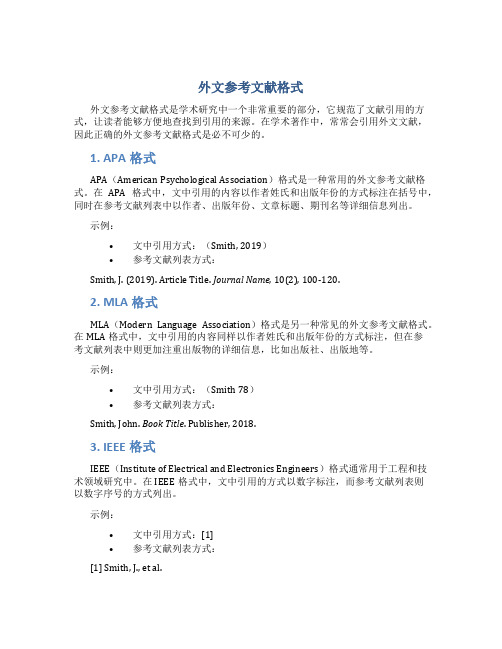
外文参考文献格式外文参考文献格式是学术研究中一个非常重要的部分,它规范了文献引用的方式,让读者能够方便地查找到引用的来源。
在学术著作中,常常会引用外文文献,因此正确的外文参考文献格式是必不可少的。
1. APA格式APA(American Psychological Association)格式是一种常用的外文参考文献格式。
在APA格式中,文中引用的内容以作者姓氏和出版年份的方式标注在括号中,同时在参考文献列表中以作者、出版年份、文章标题、期刊名等详细信息列出。
示例:•文中引用方式:(Smith, 2019)•参考文献列表方式:Smith, J. (2019). Article Title. Journal Name, 10(2), 100-120.2. MLA格式MLA(Modern Language Association)格式是另一种常见的外文参考文献格式。
在MLA格式中,文中引用的内容同样以作者姓氏和出版年份的方式标注,但在参考文献列表中则更加注重出版物的详细信息,比如出版社、出版地等。
示例:•文中引用方式:(Smith 78)•参考文献列表方式:Smith, John. Book Title. Publisher, 2018.3. IEEE格式IEEE(Institute of Electrical and Electronics Engineers)格式通常用于工程和技术领域研究中。
在IEEE格式中,文中引用的方式以数字标注,而参考文献列表则以数字序号的方式列出。
示例:•文中引用方式:[1]•参考文献列表方式:[1] Smith, J., et al.。
英语情景教学外文参考文献

英语情景教学外文参考文献以下是一些英语情景教学方面的参考文献:1. Richards, J. C., & Rodgers, T. S. (2001). Approaches and Methods in Language Teaching. Cambridge: Cambridge University Press.(理查兹和罗杰斯的《语言教学的手段与方法》)2. Willis, J., & Willis, D. (2007). Doing Task-Based Teaching. Oxford: Oxford University Press.(威利斯夫妇的《任务型教学实践》)3. Ur, P. (1996). A Course in Language Teaching: Practice and Theory. Cambridge: Cambridge University Press.(厄尔的《语言教学课程:实践与理论》)4. Nation, I. S. P., & Macalister, J. (2010). Language Curriculum Design. New York: Routledge.(纳修恩和麦卡利斯特的《语言课程设计》)5. Kumaravadivelu, B. (2003). Beyond Methods: Macrostrategies for Language Teaching. New Haven: Yale University Press.(库马拉维德卢的《方法之外:语言教学的宏观策略》)6. Harmer, J. (2007). The Practice of English Language Teaching. Harlow: Pearson Education Limited.(哈默的《英语语言教学实践》)7. Nunan, D. (1991). Language Teaching Methodology: A Textbook for Teachers. Harlow: Addison Wesley Longman Limited.(努南的《语言教学方法论:教师用教材》)8. Brown, H. D. (2000). Principles of Language Learning and Teaching. White Plains: Pearson Education.(布朗的《语言学习和教学原理》)这些参考文献覆盖了英语语言教学的不同方面,包括教学方法、课程设计以及教学策略等。
参考文献(已排序)
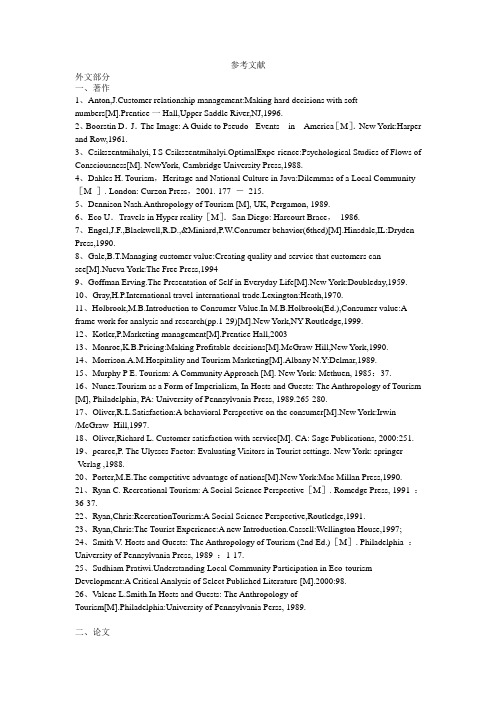
参考文献外文部分一、著作1、Anton,J.Customer relationship management:Making hard decisions with softnumbers[M].Prentice一Hall,Upper Saddle River,NJ,1996.2、Boorstin D.J.The Image: A Guide to Pseudo - Events in America[M].New York:Harper and Row,1961.3、Csikszentmihalyi, I S Csikszentmihalyi.OptimalExpe-rience:Psychological Studies of Flows of Consciousness[M]. NewYork, Cambridge University Press,1988.4、Dahles H. Tourism,Heritage and National Culture in Java:Dilemmas of a Local Community [M ]. London: Curzon Press,2001. 177 -215.5、Dennison Nash.Anthropology of Tourism [M], UK, Pergamon, 1989.6、Eco U.Travels in Hyper reality[M].San Diego: Harcourt Brace,1986.7、Engel,J.F.,Blackwell,R.D.,&Miniard,P.W.Consumer behavior(6thed)[M].Hinsdale,IL:Dryden Press,1990.8、Gale,B.T.Managing customer value:Creating quality and service that customers cansee[M].Nueva York:The Free Press,19949、Goffman Erving.The Presentation of Self in Everyday Life[M].New York:Doubleday,1959.10、Gray,H.P.International travel-international trade.Lexington:Heath,1970.11、Holbrook,M.B.Introduction to Consumer Value.In M.B.Holbrook(Ed.),Consumer value:A frame work for analysis and research(pp.1-29)[M].New York,NY Routledge,1999.12、Kotler,P.Marketing management[M].Prentice Hall,200313、Monroe,K.B.Pricing:Making Profitable decisions[M].McGraw-Hill,New York,1990.14、Morrison.A.M.Hospitality and Tourism Marketing[M].Albany N.Y:Delmar,1989.15、Murphy P E. Tourism: A Community Approach [M]. New York: Methuen, 1985:37.16、Nunez.Tourism as a Form of Imperialism, In Hosts and Guests: The Anthropology of Tourism [M], Philadelphia, PA: University of Pennsylvania Press, 1989.265-280.17、Oliver,R.L.Satisfaction:A behavioral Perspective on the consumer[M].New York:Irwin/McGraw -Hill,1997.18、Oliver,Richard L. Customer satisfaction with service[M]. CA: Sage Publications, 2000:251.19、pearce,P. The Ulysses Factor: Evaluating Visitors in Tourist settings. New York: springer-Verlag ,1988.20、Porter,M.E.The competitive advantage of nations[M].New York:Mac Millan Press,1990.21、Ryan C. Recreational Tourism: A Social Science Perspective[M]. Romedge Press, 1991 :36-37.22、Ryan,Chris:RecreationTourism:A Social Science Perspective,Routledge,1991.23、Ryan,Chris:The Tourist Experience:A new Introduction.Cassell:Wellington House,1997;24、Smith V. Hosts and Guests: The Anthropology of Tourism (2nd Ed.)[M]. Philadelphia :University of Pennsylvania Press, 1989 :1-17.25、Sudhiam Pratiwi.Understanding Local Community Participation in Eco-tourism Development:A Critical Analysis of Select Published Literature [M].2000:98.26、V alene L.Smith.In Hosts and Guests: The Anthropology ofTourism[M].Philadelphia:University of Pennsylvania Perss, 1989.二、论文1. A.Pizam, Y. Neumann, A Reichel-Dimensions of tourist satisfaction with adestination[J].Annals of Tourism Research, 1978,5(3):314-322.2.Agarwal S. Restructuring seaside tourism: The resort life cycle [J]. Annals of TourismResearch,2002,29(1):25 -55.3.Akama J. Damiannah M K. Measuring tourist satisfaction with Kenya's wildlife safari:Acase study of Tsavo West National Park[J]. Tourism Management, 2003 (24):73-81.4.AkamaJ.Western environmental values and nature based tourism in Kinya[J].TourismManagernent,1996(8):567-574.5.Alison J Beeho, Richard C Prentice. Conceptualizing the experiences ofheritage tourists—A case study of New Lanark World Heritage Village.[ J]. Tourism Management, 1997, Vol 18(2):75-87.6.Antonia B,Lee M E,McCormick P J. Residents’perceptions ofthe cultural benefits oftourism [J]. Annals of Tourism Research,2002,29(2):303 -319.7.Atila Yuksel. Shopping experience evaluation: a case of domesticand internationalvisitors[J]. Tourism Management, 2004,25(6): 751-759.8.Beard J.B. Raghed M G. Measuring leisure satisfaction[J]. Journal of Leisure Research.1980,9.Bolton,Drew. A multistage model of customers' assessments of service quality andvalue[J].Journal of Consumer, 1991, 17(4):375-384.10.Brady M.Cronin,J.Some new thoughts on conceptualizing perceived service quality:ahierarchical approach[J].Journal of Marketing,2001,65(July):34-49.11.Brian King. Social Impacts of Tourism: Host Perceptions [J]. Annals of Tourism Research,1993, 20(4).12.Browne R, Nolan. Western Indian Reservation Tourism Development [J].Annals ofTourism Research, 1989, 16: 360-376.13.Brunt P,Courtney P. Host perceptions of sociocultural impacts[J]. Annals of TourismResearch,1999,26(3):493 -515.14.Bryan J, H Brown. Personal Perception and Community Speculation:A British Resort inthe 19th Century [J].Annals of Tourism Research, 1985 (3):355-369.15.Burns P M,Mónica M S. Local perceptions of tourism planning:The case of Cuéllar,Spain [J]. Tourism Management,2003,24(3):331 -339.16.Butler R W. The concept of a tourist area cycle of evolution :Implications formanagement of resources [J]. Canadian Geographer,1980,24(1):5-12.17.Cardozo,Richard N. A Experimental Study of Consumer Effort [J]. Journal of MarketingResearch, 1965(8):42-43.18.Cees Goossens.Tourism Information and Pleasure Motivation[J].Annals of TourismResearch,2000,27(2):301-321.19.Cevat Tosun. Limits to Community Participation in the Tourism Development Process inDeveloping Contries[J].Tourism Management.2000,21(6):613一633.20.Chen,C.,Tsai,D.C.How destination image and evaluative factors affect Behavioralintentions?[J].Tourism Management,2007,(28):1115-1122.21.Chen,C.,TSai,M.H.Perceived value,satisfaction,and loyalty of TV travel productshopping:Involvement as a moderator[J].Tourism Management,2008,(29):1166-1171. 22.Chrys Horn, David Simmons, Community adaptation to tourism: Comparisons betweenRotorua and Kaikoura[J]New Zealand Tourism Management2002,23:133—143.23.Cohen E. A Phenomenology of tourist experiences[J]. Sociology,1979,13(2):179-201.24.Cohen E. towards a Sociology of lnternational Tourism [J]. Social Research, 1972(1).25.Cohen E.Authenticity and Commoditization in tourism[J].Annals of Tourism Research,1988,15 (2):371~386.26.Cohen E.Rethinking the sociology of tourism[J].Annals of Tourism Research,1979,6(1):18~35.27.Cohen J H. Textile,tourism and community development [J].Annals of TourismResearch,2001,28(2):378 -398.28.Cravens,D.W.,Holland,C.W.,&Lamb,C.W.J.,etal.Marketing’s role in product and servicequality[J].Industrial Marketing Management,1988,17(November):285-304.29.Culler J.Semiotics of tourism[J].The American Journal of Semiotics,1981,1(12):127-140.30.Dann,G:Anomie,Ego-Enhancement and Tourisms[J]. Annals of TourismResearch,1977,vol.4(4):184-194.31.Day,R.L.Modeling choices among alternative responses to dissatisfaction [J].Advances inConsumer Research, 1984,11(l):496-499.32.Dogan G,Jurowski C,Uysal M. Resident attitudes: A structuralmodeling approach [J].Annals of Tourism Research,2002,29(1):79 -105.33.Dogan H Z. Forms of adjustment :Sociocultural impacts of tourism[J]. Annals ofTourism Research, 1989, 16(2):216-236.34.Dyer P,Aberdeen L,Schuler S. Tourism impacts on anAustralian indigenouscommunity: A Djabugay case study [J].Tourism Management,2003,24(1):83 -95.35.Erb M. Understanding tourists: Interpretations from Indonesia[J]. Annals of TourismResearch,2000,27(3):709 -736.36.Faulkner B,Vikulov S. Katherine,washed out one day,back ontrack the next: Apost-mortem of a tourism disaster[J]. TourismManagement,2001,22(4):331 -344.37.Fornell,C.,Johnson,M.D.,Anderson,E.W.,Cha,J.,&Bryant,B.E.,The American customerSatisfaction Index:Nature,Purpose and Findings[J].Journal of Marketing,1996,(60):7-18. 38.Foster D M,Murphy P. Resort Cycle Revisited the Retirement Connection[ J]. Annals ofTourism Research,1991 (4),553-576.39.Gronroos, P. Value-driven relational marketing: from product s to resources andcompetences[J]. Journal of Marketing Management, 1997, 13: 42-46.40.Gronroos, P. Value-driven relational marketing: from product s to resources andcompetences[J]. Journal ofMarketing Management, 1997, 13:42-46.41.Horn C,Simmons D. Community adaptation to tourism:Comparisons between Rotoruaand Kaikoura,New Zealand [J].Tourism Management,2002,23(2):133 -143.42.Hughes,G. Authenticity in tourism[J].Annals of Tourism Research, 1995,22(4):781-803.43.Hunt,J.D.Image as a factor in tourism development[J].Journal of TravelResearch,1975,(13):3-7.44.Joaquin Alegre. Tourist satisfaction and dissatisfaction[J]. Annals of TourismResearch,2010,37: 52-73.45.Joar Vitters,Marit Vorkinn,Odd Inge Vistad,Jorid Vaagland.Tourist experiences andattractions[J].Annals ofTourism Research, 2000,27(2): 432-450.46.Juanita C Liu, Pauline J Sheldom,Turgut Vat.Resident Perception of the EnvironmentalImpacts of Tourism [J]. Annals of Tourism Research, 1987(1).47.Juergen Gnoth. Tourism motivation and expectation formation[J].Annals of TourismResearch,1997,Vol.24(2):283-304.48.Julio Aramberri.The Host Should Get Lost Paradigms in the Tourism Theory[J]. Annals ofTourism Research. 2001(3):738-761.urie K M. Commoditizing culture: Tourism and Maya identity[J]. Annals of TourismResearch,2003,30(2):353 -368.ws E. Conceptualizing visitor satisfaction management in heritage settings: Anexploratory blueprinting analysis of Leeds Castle Kent[J].Tourism Management, 1998, 19(6):545-554.xson Joan.How “We”See “Them”: Tourism and Native Americans [J]. Annals ofTourism Research, 1991, 18: 365-391.52.MacCannell D.Staged authenticity: arrangements of social space in tourist settings[J].American Journal of Sociology,1973,(79):589~602.53.María R Y P. Rural tourism in Spain [J]. Annals of TourismResearch,2002,29(4): 1101-1110.54.Mervyn S Jackson, Gerard N White, Claire L Schmierer.Tourism experienceswithin anattributional framework[J].Annals ofTourism Research, 1996,23(4):798-810.55.Mitchell,munity Integration:Island Tourism in Peru[J].Annals of TourismResearch,2001,38(l):113-13956.Moya K. Rural cultural economy: Tourism and social relations[J]. Annals of TourismResearch,2001,28(3):762 -783.57.Nelson Graburn.The Anthropology of Tourism [J].Annals of Tourism Research, 1983.emeyer,R.G,Krishnan,B.,&Pullig,C.,etal.Developing and validating measures offacetsof customer-based brand equity[J].Journal of Business Research,2004,57:209-224. 59.Nunez T. Tourism, tradition, and acculturation: Weekendismo in a Mexican village[J]. Ethnology, 1963,2(3):347-352.60.Oliver, Richard L.,Cognitive, “Affective and Attribute Bases of the SatisfactionResponse”[J]. Journal of Consumer Satisfaction, 1993,Vol.20(Dec),419.61.Oliver,R.L.,Desarbo,W.S.Response determinants of satisfaction judgements [J].Journal ofconsumer research,1988,14(4):495-507.62.Oliver,R.L.Measurement and evaluation of satisfaction Processes in retailsettings[J].Journal of Retailing, 1981,(57):2-48.63.Oliver,R.L.Whence consumer loyalty?〔J].Journal of Marketing,1999,63(specialissue):33-44.64.Philip L. Pearce. Tourist-Guide Interaction[J]. Annals of Tourism Research,1984(11):129-146.65.Pizam A. Tourism's impacts: The social costs to the destination community as perceivedby its residents[J]. Journal of Travel Research, 1978,3:8-12.66.R W Butler. The Concept of a Tourist Area Cycle of Evolution: Implications forManagement of Resources [J]. Canadian Geographer. 1980, 24 (1):5-12.67.Reisinger, Y.,Steiner, C. J. Reconceptualizing object-based authenticity[J].Annals ofTourism Research, 2006,33(1), 65-86.68.Rodrigo A G. Tourism and cultural revival [J]. Annals ofTourism Research,2002,29(4):1004 -1021.69.Ross G. Tourist Destination Images of the Wet Tropical Rainforests of North Queensland[J].Australian Psycho-logist, 1991, 26: 153~15770.S.E.Iso-Ahola.Towards a social psychology of tourism motivation:A rejoinder[J].Annalsof Tourism Research,1982,vol.9(2):256-262.71.Shankar,V,Smith,A.K.,&Rangaswamy,A.Customer satisfaction and loyalty in online andoffline environments [J].International Journal of Research in marketing,2003,20:153-175.72.Simmons D G. Community participation in tourism planning [J].Tourism Management,1994(15):98-108.73.Sirakaya,E.Teye,V.and Sonmez,S.Understanding Residents’Support for TourismDevelopment in the CentralRegion of Ghana[J」.Journal of TravelResearch,2002,(41):57-67.74.Slater, L.&Narver, B. Market orientation, customer value, and superiorperformance[J]. Business Horizons, 1994, 37(2):22-28.75.Stevens,B.F.Price Value Perceptions of Travelers[J].Journal of Travel Research,1992,(31):44-48.76.Tosun C. Host perceptions of impacts: A comparative tourismstudy [J ]. Annals ofTourism Research,2002,29 ( 1 ): 231 -253.77.UNESCO.The Effects of Tourism on Sociol cultural Values[J]. Annals of TourismResearch,1977(4):74-105.78.Walpole M J,Goodwin H J. Local economic impacts of Dragontourism in Indonesia [J].Annals of Tourism Research,2000,27(3):559 -576.79.Wang Ning. Rethinking authenticity in tourism experience[J]. Annals ofTourism Research,1999, 26(2): 349-370.80.Wickens E. The sacred and the profane: A tourist typology[J].Annals of TourismResearch,2002,29(3): 834 -851.81.Williams J,Lawson R. Community issues and resident opinions oftourism [J]. Annals ofTourism Research,2001,28 ( 2 ):269 -290.82.Woodruff,R.B.Customer Value:The next source of competitive advantage[J].Journal of theA cademy of Marketing Science,1997,25(2):139-53.83.Woodruff,R.Customer value:the next source for competitive advantage[J].Academy ofMarketing Science,1997,25(2):124-129.84.Yinghua Liu, SooCheong Jang. Perceptions of Chinese restaurants in the U.S.: Whataffects customer satisfaction and behavioral intentions? [J]. International Journal ofHospitality Management, 2009,28:338-348.中文部分一、著作1.[宋]高承.事物记原:卷7 .州郡方域部·镇[M ].北京:中华书局, 1989 .2.Yvette Reisinger,Lindsay W.Tunrer.著,朱路平.译.旅游跨文化行为研究[M].天津:南开大学出版社,2004.3.保继刚,楚义芳.旅游地理学[M].高等教育出版社,1999.4.保继刚,等.旅游开发研究-原理、方法、实践.北京:科学出版社,1996.5.丹尼逊·纳什.著,宋晓莲.译.旅游人类学.昆明:云南大学出版社,2004.6.邓永进,薛群慧,赵伯乐.民俗风情游[M].昆明:云南大学出版社,2001.7.菲利浦·科特勒著,梅清豪译.营销管理(第11版)〔M〕.上海:上海人民出版社,2003.8.甘枝茂,马耀峰.旅游资源与开发.天津:南开大学出版社,2000.9.龚绍力.旅游规划与开发[M].郑州:郑州大学出版社,2007.10.何肇发,黎熙元.社区概论.广州:中山大学出版社,1991.11.李天元.中国旅游可持续发展研究.天津:南开大学出版社,2004.12.《中国古镇游》编辑部.古镇古村游[M].西安:陕西师范大学出版社,2006.13.刘纯.旅游心理学.北京:科学出版社,2004.14.罗朝金.《神奇古镇黄龙溪》[M].成都:电子科技大学出版社,1997.15.马耀峰,李天顺,刘新平.旅游者行为[M].北京: 科学出版社,2008.16.马勇,李玺.旅游景区管理.北京:中国旅游出版社,2006.17.彭兆荣.旅游人类学.北京:民族出版社,2004.18.阮仪三、王景慧、王林.历史文化名城保护理论与规划[M].上海:同济大学出版社,1998.19.阮仪三. 江南六镇[M ].石家庄: 河北教育出版社, 2002 .20.双流县地方志编纂委员会编.《双流县志》[M].成都,四川人民出版社,2000.21.田里.旅游学概论[M].天津:南开大学出版社,2001.22.瓦伦·L·史密斯.著,张晓萍,何昌邑.等译.东道主与游客-旅游人类学研究.昆明:云南大学出版社,2007.23.Clare A Gunn, Turgut Var著,吴必虎,等译.旅游规划理论与案例(第四版).大连:东北财经大学出版社,2005.4.24.威廉.瑟厄波德.著, 张广瑞.等.译.全球旅游新论[M].北京:中国旅游出版社,2001.25.魏小安.旅游目的地发展实证研究.北京:中国旅游出版社,200226.谢彦君.基础旅游学.(第二版)[M]北京:中国旅游出版社,2004.27.新唐书·兵志[M ].北京:中华书局, 1975 .28.徐德宽.现代旅游市场营销学[M].青岛:青岛出版社,1998.29.约瑟夫·派恩,詹姆斯·H·吉尔摩,夏业良等译. 体验经济[M].北京:机械工业出版社,2002.30.张建萍.生态旅游理论与实践.北京:中国旅游出版社,2001.31.章海荣.旅游文化学.上海:复旦大学出版社,2004.32.郑召利.哈贝马斯的交往行为理论.上海:复旦大学出版社,2002.33.中共双流县委宣传部,黄龙溪省级风景名胜区管委会. 古镇黄龙溪[M].成都: 巴蜀书社,2006.34.Garrod Brian,Fyall Alan.著,方瑜.译.旅游吸引物管理新的方向.大连:东北财经大学出版社,2005.35.邹统钎.旅游景区开发与经营经典案例.北京:旅游教育出版社,2003.36.J.克里斯托弗·霍洛韦.著, 向萍,杜江,张伯山.译.旅游业[M].桂林:漓江出版社,1987.37.J.克里斯托弗·霍洛韦.著,向萍,杜江,张伯山.译.旅游业.桂林:漓江出版社,1987.38.Peter E.Murphy,Ann E.Murphy.著.陶犁,邓衡,张兵.等译.旅游社区战略管理:弥合旅游差距[M].天津:南开大学出版社,2005.39.R.麦金托什.S,格波特. 著,蒲红.等译.旅游学.上海:上海文化出版社,1985.40.Turgt Var.周常春等译.基于社区的旅游规划方法.国际旅游规划案例分析[M].南开大学出社,2004.二、论文1、邹1.《中国古镇游》采编组.中国古镇游[G].陕西:陕西师范大学,2009:6-7.2.鲍蕊. 浅析古镇旅游产品的深度开发[J].绵阳师范学院学报,2011,(6):50 -52.3.鲍蕊.关于古镇旅游可持续发展的思考[J]. 四川烹饪高等专科学校学报2009,(3):48 -50.4.卞显红.保护区生态旅游与生物多样性保护及当地社区的关系分析[J].北京第二外国语学院学报, 2003(5): 13-15.5.曹辉林.水运码头:双重“生与熟”共构的二元“居与游”世界[J].山东科技大学学报2013,15(3):61-76.6.曹莉萍.周庄古镇休闲旅游发展研究[D].太原:山西财经大学,2008.7.曹诗图,曹国新,邓苏.对旅游本质的哲学辨析[J] .旅游科学,2011,25(1)81-88.8.陈才,卢昌崇.认同:旅游体验研究的新视角[J].2011,26(3):37-42.9.陈汉波. 论江南传统古镇的文化特征及其成因[J]. 中共浙江省委党校学报,2000,(5):72 -77.10.陈金华,李洪波.试论自然保护区生态旅游社区参与[J].北京第二外国语学院学报,2005,(1):11-15.11.陈娟.体验型旅游产品的开发设计研究[D].大连:大连海事大学,2006.12.陈丽荣.不同类型旅游者体验质量[D].芜湖:安徽师范大学,2007.650.13.陈亮.基于体验视角的民族村寨旅游产品开发研究[D].成都:成都理工大学,2012.14.陈琴,李俊,张述林. 基于文化再生理念的古镇实心化开发模式研究[J]. 安徽农业科学,2011,(25):15519-115.陈琴,李俊,张述林.基于文化再生理念的古镇实心化开发模式研究[J].安徽农业科学,2011,39(25):15518-1552016.陈勤建. 文化旅游:摒除伪民俗,开掘真民俗[J]. 民俗研究,2002,(2):5 -9.17.陈冉.文化遗产类体验旅游产品开发研究[D].成都:成都理工大学,2011.18.陈伟凤,陈刚华,黄远水:遗产旅游体验的真实性及其塑造途径研究[J].桂林旅游高等专科学校学报,2008,19(2):182-19.陈享尔,蔡建明.旅游客体真实性与主体真实性集合式关系探讨[J].人文地理,2012,126(4):153-160.20.陈兴.“虚拟真实”原则指导下的旅游体验塑造研究:基于人类学视角[J].旅游学刊,2010( 11) :14.21.程志勇.古镇旅游动机及旅游开发研究[D].重庆:重庆师范大学,2010.22.邓小艳.基于建构主义原真性理论对非物质文化遗产旅游开发的解读[J]. 贵州民族研究,2010,31(2):90-95.23.董观志,杨凤影.旅游景区游客满意度测评体系研究[J].旅游学刊,2005,(1):27-30.24.窦清.论旅游体验[D].南宁:广西大学,2003,23-26.25.房艳刚,刘继生.中国自然保护区基于社区的生态旅游发展研究[J].干早区资源与环境,2006,20(l):37-41.26.符全胜.旅游目的地游客满意理论研究综述[J].地理与地理信息科学.2005,21(5):90-94.27.高德兴,王琦.试论民俗旅游中文化差异对主客交往的影响-以永定客家土楼民俗文化村为例[J].江南大学学报(人文学版),2008(2):107-111.206、方宏烨.全球化背景下旅游者与东道主的交往文化[J].郑州大学学报(哲学社版),2008(2):74-76.28.高小华.旅游产品体验性设计[D].扬州:扬州大学,2008,I.29.葛红丽.基于游客体验的主题公园品牌塑造研究[D].济南:山东大学,2009.30.郭凌,王志章.论民族地区旅游社区参与主体的培育——以泸沽湖里格岛为例[J].广西师范大学学报:哲学社版,2009(3):110-115.31.郭栩东.浅析古镇旅游业的政府治理绩效[J].华中师范大学学报(社科版),2013,(4):10-13.32.何大义、刘建生.构建中国顾客满意度指数CCSI 的设想[J].世界标准化与质量管理,2000(10):7-10.33.何桢强,何力成.上海旅游业的发展应导入社会公德内容[J].旅游学刊,1997(2):33-36.34.何祯强,何力成.上海旅游业的发展应导入社会公德内容[J].旅游学刊1997,(2):33一36.35.黄大勇,曹扬. 古镇旅游商品游客需求特征分析及创新开发的思路[J]. 开发研究,2007,(6):97 -99.36.黄大勇,曹扬.古镇旅游商品游客需求特征分析及创新开发的思路[J].开发研究,2007, (6):97 - 99.37.黄贵仁.体验经济背景下的旅游开发研究[D].南昌:南昌大学,2010.38.黄敏.基于共生理论的利益相关者管理研究[D].昆明:云南大学,2011,35.39.黄晓娟.不同类型旅游景区游客体验与满意度关系差异性研究[D]成都:西南财经大学,2009.1-2.40.黄颖华,黄福才.旅游者感知价值模型、测度与实证研究[J].旅游刊,2007,22(8):42-47.41.贾秉瑜.体验经济视角下旅游产品体验性研究[D].北京:北京第二外国语学院,2007.42.贾玉新.言语行为和言语行为能力[J].外语学刊,1997(2):7-10.43.江五七,陈豫. 江南水乡传统古镇旅游传统遗韵的开发与保护[J]. 商业研究,2003,(8):178 -180.44.姜海涛.旅游场:旅游体验研究的新视角[J].桂林旅游高等专科学校学报,2008,19(3):321-325.45.蒋志杰. 江南水乡古镇文化旅游策划研究[D]. 上海:上海师范大学,2004,22-35.46.堪莉.旅游景区游客体验研究—以中山陵风景区为例[D].南京:南京师范大学,2003.47.郎富平.原真型古镇旅游的可持续发展研究[J].浙江学刊,2012,(5):179 -185.48.黎洁,赵西萍.社区参与旅游发展理论的若干经济学质疑[J].旅游学刊,2001,16(4):44-47.49.李蓓.从人文关怀角度浅议古镇旅游管理模式[N].中国旅游报,2010-7-26(7 ).50.李东和,张捷,卢松,等.苏州水乡古镇旅游形象定位研究[J]. 地域研究与开发,2007,26(2):81 -85.51.李海娥.体验营销在旅游业中的引入和应用研究[D].武汉:武汉大学,2004.52.李怀兰.旅游体验效用因素分析[D].南宁:广西大学,2004,51.53.李慧茹.基于游客满意度的青岛崂山区旅游开发对策研究[D]. 中国海洋大学,2012.54.李建峰.文化旅游体验层次模式初探[J]. 河北民族师范学院学报,2012,32(4):36-38.55.李健,曾绍伦,杨方琳. 罗城历史文化名镇旅游资源特色与可持续发展探讨[J]. 生态经济,2005,(11):10356.李鉴踪. 古镇保护与开发的博弈学思考[J].文史杂志2006,(5):30 -32.57.李经龙,张小林.旅游体验——旅游规划的新视角[J].地理与地理科学,2005,(6):91-95.58.李淼.旅游群体规模与旅游体验质量:针对旅游群体成员间互动过程的实证分析[D].大连:东北财经大学,2004.50-5359.李明辉.基于体验视角的乡村游客满意度研究[D].杭州:杭州电子科技大学,2012.I.60.李普男.影视主题公园旅游体验质量测评体系构建与实证研究[D].无锡:江南大学,2012:I.61.李倩,吴小根,汤澍. 古镇旅游开发及其商业化现象初探[J]. 旅游学刊,2006,(12):52 -57.62.李琴.剑门蜀道风景名胜区体验旅游产品的深度开发[D].成都:成都理工大学,2006.63.李苏宁.江南古镇保护与开发的博弈思考[J]. 小城镇建设,2007,(3):73 -76.64.李苏宁.江南古镇保护与开发的博弈思考[J]. 小城镇建设,2007,(3):73 -76.65.李晓琴.旅游体验影响因素与动态模型的建立[J]. 桂林旅游高等专科学校学报,2006,17(5):609-611.66.李晓琴.旅游体验影响因素与动态模型的建立[J].桂林旅游高等专科学校学报,2006,(5):609-611.67.李旭东.旅游体验的客体真实和主体本真[J].北京第二外国语学院学报,2008,(5):26-30.68.李耀珍.旅游体验对旅游动机的影响研究[J].人民论坛,2010,299(8):152-153.69.李瑛.旅游目的地游客满意度及影响因子分析[J].旅游学刊,2008,(4):43-48.70.李作战.西方顾客满意理论研究述评[J].商业时代.2006,(2):24-25.71.连漪,汪侠.旅游地顾客满意度测评指标体系的研究及应用[J]. 旅游学刊,2004.5:9-13.72.梁明珠.生态旅游与“三农”利益保障机制探讨[J].旅游学刊,2004(6):69-72.73.梁旺兵.跨文化视角中的旅游客主交互与客地关系研究[D].陕西师范大学博士学位论文.2006.74.梁旺兵.西安外国游客与当地居民的旅游交往行为研究[J].干旱区资源与环境,2008(9):182-187.75.廖丹,李小波.千年田园诗天府水码头[J].西部广播电视2008(7):172-173.76.林爱平.社区参与角度下的福建土楼旅游开发[J].闽江学院学报,2009( 6):88.77.林移刚. 古镇旅游产品体验化的设计与创新[J]. 经济论坛,2011,(12):147 -149.78.刘佳、张捷、顾朝林. 旅游规划中空间竞争与区域合作研究[J].人文地理,2005,(3):79 -83.79.刘德光,徐宁珺.旅游体验营销的模式研究[J]. 财贸经济,2006(7):30-33.80.刘德谦. 古镇保护与旅游利用的良性互动[J].旅游学刊,2005,(2):47 -53.81.刘晶会.江南古镇社区参与旅游发展研究[D].上海:上海师范大学,2007,5.82.刘军林.旅游体验质量评价体系模型及分析[J].天津商业大学学报2010,30(6):19-23.83.刘纬华.关于社区参与旅游发展的若干理论思考[J].旅游学刊,2000,(1):47一52.84.刘啸.基于真性旅游的旅游动机3D指向分类法研究[J].干旱区资源与环境,2013(7):192-196.85.刘欣.基于体验营销理论的科技旅游产品开发研究[D].南京:南京师范大学,2007.86.刘焱.基于社区参与的古镇旅游发展分析[J].哈尔滨商业大学学报(社会科学版),2006,(4):77 -79.87.刘宇.四川古镇旅游地生命周期影响因素研究[D]成都:西南交通大学,2007.88.龙江智,卢昌崇.旅游体验的层级模式:基于意识谱理论的分析[J].北京第二外国语学院学报,2009,(11):9-19.89.卢军霞.基于游客体验的古镇旅游产品开发研究[D].杭州:浙江大学,2005,I.90.卢璐.古村落旅游区主客交往与互容性研究[D].西安:陕西师范大学,2011.91.罗宏翔.小城镇在我国人类聚落体系中的位置[J]学术论坛,2000,(4):23-26.92.罗文,陈国生,赵毅. 21 世纪双江历史文化名镇旅游地形象DI 战略[J]. 经济地理,2000,(7):122 -125.93.罗燕,胡平.古镇旅游解说系统实证研究[J].北京第二外国语学院学报,2008,(5):63 -38.94.马潇.城市体验型旅游产品开发研究[D].广州:华南师范大学,2007.95.孟庆良,韩玉启,陈晓君.客户价值研究及其对客户关系管理绩效的影响[J].96.孟威,苏勤.历史城镇类旅游地居民交往偏好分化及测度——以周庄为例[J].旅游学刊,2009(5):54-60.97.孟威,苏勤.旅游主客交往对社区居民影响的分析模型——以周庄为例.旅游论坛, 2010(3):293-298.98.孟威,苏勤.旅游主客交往对社区居民影响的分析模型——以周庄为例[J].旅游论坛,2010(3):293-298.99.缪芳.乡村旅游地游客满意度测量研究[D].福州:福建师范大学,2007.100.乃举. 安徽三河古镇旅游形象与地域脉络研究[J]. 国土资源科技管理,2006,(4):108 -112.101.南剑飞,李蔚.基于灰色系统理论的旅游景区游客满意度评价研究[J].商业研究,2008,(12):46-49.102.潘海颖.旅游体验审美精神论[J].旅游学刊,2012,27(5):88-93.103.潘雪阳.基干利益相关者理论的四川古镇旅游经营管理模式研究[D].成都:西南交通大学,2009,49.104.庞式博姚岚. 四川古镇旅游商品开发现状及对策研究[J].成都大学学报(社科版),2008,(3):35 -38. 105.彭小娟. 浅析保护历史文化名镇的两种现象[J]. 山西建筑,2005,(21):29 -30.106.皮平凡.体验经济时代的旅游产品开发探索[J] .学术交流, 2005,(2): 66- 69 .107.秦美玉.民族节事旅游体验质量评价及对策研究[J]贵州民族研究, 2013,34(3):94-97.108.秦容. 历史文化名镇的旅游开发[J]. 乐山师范学院学报,2007,(1):79 -81.109.阮仪三,邵勇,林林. 江南水乡城镇的特色、价值与保护[J]. 城市规划汇刊,2002,(1):1 -4.110.阮仪三,邵勇. 江南水乡古镇的特色与保护[J]. 同济大学学报(社会科学版),1996,(1):21 -28.111.阮仪三.保护周庄古镇的艰辛历程[J].衡阳师范学院学报2005(2):1-8.112.芮田生.旅游体验与旅游产品策划研究[D].成都:四川大学,2007.113.师谦友,张哲,龙晓霞.开发工业旅游SEE可预见效益分析及模式推举—以蒙牛乳业为例[J].内蒙古师范报,2008,37(2):250一253.114.史常凯.论体验经济时代的体育旅游营销[J].商业时代·学术评论,2006,(20):22-23.115.宋咏梅,孙根年.论体验经济的理论构架与塑造原则[J].社会科学家,2006,(6):115-119.116.宋玉蓉. 四川古镇空间结构特征及区域旅游合作分析[J].资源开发与市场,2009 ,25(8):764 -766.117.宋章海,韩百娟. 强化社区参与在我国遗产旅游地中的有效作用[J]地域研究与开发,2007( 5):89-92.118.宋章海.试论社区参与在区域旅游发展中的问题与对策[J].贵州大学学报,2005,23(l):62一65.119.苏彩云.体验经济背景下古都旅游产品的体验化开发研究[D]. 长春:东北师范大学,2010.120.苏勤.旅游者类型及其体验质量研究[J].地理科学,2004,(4):506-511.121.孙根年.塑造高质量旅游体验的路径分析[J].陕西师范大学继续教育学报,2007,24(1):122-124.122.孙坚烽. 江南水乡古镇旅游跳出雷同化之研究[J].农村经济与科技2009,(8):33 -34.123.孙九霞,保继刚.社区参与的旅游人类学研究——以西双版纳傣族园为例[J].广西民族学院学报:哲学社版,2004( 6):128-136.124.谭宏. 古镇保护与开发的保障机制[J].城市问题,2010,(10):55 -60.125.谭林,李光金.论旅游目的地的评价体系[J].西南民族学院学报(哲学社会科学版),2001,22(2):150.126.陶伟,戴光全. 区域旅游发展的“竞合模式”探索:以苏南三镇为例[J]. 人文地理,2002,(4):29 -34. 127.田坤跃.基于Fuzzy-IPA的景区游客满意度影响因素的实证研究[J].旅游学刊,2010,(5):61-65.128.田文红. 成都地区古镇文化定位探析[J].中华文化论坛,2012,(5):129 -132.129.佟静,张丽华.旅游体验的层次性及影响因素分析[J].2010,33(1):41-43.130.汪侠,顾朝林.旅游景区顾客的满意度指数模型[J].地理学报,2005,(5):807-816.131.汪侠,刘泽华,张洪.游客满意度研究综述与展望[J]. 北京第二外国语学院学报,2010.1:22-29.132.王成慧,叶生洪.顾客价值理论的发展分析及对实践的启示[J] .价值工程,2002(6): 24-27.133.王帆,赵振斌.基于游客体验的古村落旅游景观展示研究[J].北京第二外国语学院学报2009,(11):71-78.134.王镜.基于遗产生态和旅游体验的西安遗产旅游开发模式研究[D].西安:陕西师范大学,2008.135.王恺多.磁器口古镇文化保护与旅游发展对策研究[D].重庆:重庆师范大学,2011.136.王莉. 传统村镇旅游地居民态度与开发策略研究[D]. 芜湖:安徽师范大学,2004.137.王曼娜.谈休闲旅游产品及其体验营销策略[J].商业时代,2009,(23):34-35.138.王妙,孙亚平.旅游对接待地的社会文化影响[J].天津商学院学报,2001(12):35-37.139.王荣珍.旅游体验营销策略研究[D] 青岛:中国海洋大学,2010.140.王晓蓉.森林旅游体验营销策略研究[D].兰州:兰州大学,2007.13-31.141.王筱春,赵世林.论石林旅游业的可持续发展[J].云南民族学院学报,2002,19(3):36一39.142.王秀红,杨桂华,张晓萍.旅游存在真实性的思考[J]. 思想战线,2010,36(4):118-123.143.王雪梅,徐红罡,保继刚.城市更新-国外城市老文化街区的保护与再开发[J].现代城市研究,2005(11): 12- 21.144.王雪梅. 论古镇旅游资源的开发[J]. 四川师范大学学报(社会科学版),2004,(9):116 -121.145.王艳平,宦震丹.客我立场的旅游体验及多主体搭建[J]. 大连民族学院学报,2013,15(2):178-181.146.王艳平,金丽.增长界面:提高旅游体验总量的重要环节[J].旅游学刊,2004,(5):45-47.147.王莹.古镇主题化旅游开发初步研究[D].成都:成都理工大学,2010.148.王云才. 江南六镇旅游发展模式的比较及持续利用对策[J]. 华中师范大学学报,2006,(1):104 -109.149.魏柯.四川古镇建筑艺术与文化价值的解读[J].西南民族大学学报,2009,219(11):147-150.150.魏小安,魏诗华.旅游情景规划与项目体验设计[J].旅游科学,2004,(4):38-44.151.文彤,廖海牧.香港居民对内地游客旅游行为感知研究[J],旅游论坛,2009(4):504-508.152.吴承照,肖建莉. 古村落可持续发展的文化生态策略[J]. 城市规划汇刊,2003,(4):56-60.153.吴天香.凤凰古城游客体验质量评价研究[D].上海:华东师范大学,2009:74-76.154.武虹剑,龙江智.旅游体验生成途径的理论模型[J].社会科学辑刊,2009,(3):46-49.155.武永红,范秀成.基于顾客价值的企业竞争力整合模型探析[J].中国软科学,2009(11):86-92.156.肖刚.体验经济视角下的非物质文化遗产旅游开发模式研究[D].兰州:西北师范大学, 2010.157.肖琼. 基于利益相关者的民族旅游城镇可持续发展研究[J].城市发展研究,2009,(10):102 -105.158.谢小平,王忠民.利益冲突的制度分析[J].长安大学学报(社会科学版),2003(1):40-43.159.谢彦君.旅游交往问题初探[J].旅游学刊,1999(4):57.160.谢彦君.旅游体验的两极情感模型:快乐—痛苦[J].财经问题研究,2006,(5):88-92.161.谢彦君.旅游体验的情景模型:旅游场[J].财经问题研究,2005,(12):64-69.162.谢彦君.旅游体验研究——一种现象学的视角[D].大连:东北财经大学,2005.107-122.163.邢夫敏. 江南古镇旅游景区合作影响因素实证方法研究探索[J].社会科学家,2007,(7):121 -125.164.熊侠仙,张松,周俭. 江南传统古镇旅游开发的问题与对策———对周庄、同里、甪直旅游状况的调查分析[J 规划汇刊,2002,(6):61 -63.165.许洪杰.旅游开发背景下古镇居民“边缘化”现象研究[D].南宁:广西师范学院,2011.166.杨桂红.试论社区居民参与旅游业发展对环境保护的积极作用——以碧塔海旅游景区为例[J]. 经济问题探索,200-126.167.杨宏伟.城市旅游交往中的文化传递与冲突[J].太原师范学院学报(社会科学版),2007(3):38-40.168.姚银银.游憩涉入、地方依恋对旅游体验质量的影响研究[D].辽宁:东北财经大学,2011: I169.姚钟华.企业获取核心竞争力的顾客价值分析[J].江西社会科学,2002(02):145-146.170.叶志桂.西方顾客价值研究理论综述[J].北京工商大学学报,2004,19(4):11-18.董大海,权晓研,曲晓飞.顾客价值及其大连理工大学学报,1999(2):l8.171.殷果.乡村旅游主客交往行为实证研究[D].南京:南京师范大学,2011,26.172.尹殿格.基于体验经济的旅游景区营销策略研究[D].天津:河北工业大学,2008:60.173.尹乐,苏勤. 周庄旅游者的结构特征及利益追求[J]. 资源开发与市场,2005,21(4):375 -377.174.于萍.社区参与古镇旅游发展研究[J].安徽农业科学2011,39( 31) :19270 -19271,19274.175.余华玲.川西古镇开发模式初探[J].地方文化研究辑刊,2008(1):172-178.176.俞琪. 从体验经济视角探求古镇旅游产品的深度开发[J]. 江西科技师范学院学报,2008,(2):41 -43. 177.禹雯昕.基于游客满意度的民俗旅游开发研究[D]. 成都:西南财经大学,2008.2.178.运筹与管理,2005(1):139-142.179.张成杰.旅游景区游客体验价值评价研究[D].广州:暨南大学,2006.55.180.张程薇.农家乐体验营销研究[D].武汉:华中农业大学,2008.181.张迪.乡村旅游游客感知价值研究[D].杭州:浙江大学,2006.182.张冬婷,邱扶东.国内外古镇旅游研究综述[J].旅游学刊,2011(3)::86-92.183.张贵华,石青辉.体验营销在休闲农业中的应用研究[J].湘潭大学学报,2010(3):87-91.184.张国茂.古镇游客满意度测评指标体系构建与测评探讨[D].西南财经大学,2008.185.张建. 论古镇旅游流引导规划的路径[J]. 旅游论坛,2008,(8):49 -54.186.张建萍.生态旅游与当地居民利益—肯尼亚生态旅游成功经验分析[J].旅游学刊,2003,18(l):60一63.187.张良斌.基于ASEB分析框架的历史文化遗产旅游体验研究[D].华东师范大学,2009.188.张陆,徐刚,夏文汇.旅游产品的内涵、类型划分及价值问题研究[J].重庆工学院学报,2001,15(1):10189.张赵晋.体验营销在酒店业中的应用研究[J].市场论坛,2011(6):78-80.190.张哲乐. 浅析成都古镇旅游的雷同性问题[J]. 商业时代,2007,(6):109 -110.191.章玉钧.保护古镇、传承民俗、促进旅游发展[J].中华文化论坛,2006,(1):116-117.192.郑群明,钟林生.参与式乡村旅游开发模式探讨[J].,旅游学刊,2004,19(4):33-37.193.郑向敏,田苗苗.体验营销在饭店经营中的应用[J].桂林旅游高等专科学校学报,2005,16(4):34-37.194.钟国庆.旅游体验真实性规律与景区经营管理问题[J].桂林旅游高等专科学校学报,2004,15(4):40-43.195.周广鹏,余志远.旅游体验: 从视觉凝视到精神升华[J]. 商业研究,2011(12):175-180.196.周丽洁,熊礼明.生态旅游的社区参与型发展道路探讨[J].商业时代,2008(29):81-82.197.周霓.基于体验营销理论的旅游产品开发策略研究[J].经济论坛,2008,(3):107-108.198.周伟伟.世界遗产地游客体验满意度研究[D].郑州:河南大学,2011.I.199.周武生,邓梅.体验式旅游资源开发模式探讨[J].湘潭大学学报( 哲学社会科学版),2006(29):166-169.200.周亚庆,吴茂英,周永广,等.旅游研究中的真实性理论及其比较[J].旅游学刊,2007,22(6):42-47.201.朱涛.体验营销在景区品牌运作中的应用研究[D].重庆:西南大学,2007.202.诸葛仁.武夷山自然保护区资源管理中社区参与机制的探讨[J].农村生态环境,2000(1):47-52.203.庄志民.关于体验型旅游产品设计的发散性思考[J].江西科技师范学院学报,2005,(4):12-15.。
学生考试系统外文参考文献

学生考试系统外文参考文献以下是一些关于学生考试系统的外文参考文献:1."A Comprehensive Framework for Online Exam Management System," by Ravi Shankar and Deepak Suryawanshi. Journal of Computer Science and Technology, vol. 32, no. 4, 2017, pp. 775-787.2."Exam Management System: Design and Implementation," by Nidhi Jain and Anil K. Jain. International Journal of Computer Applications, vol. 138, no. 4, 2017, pp. 1-5.3."Cloud-Based Online Exam Management System," by Sunil Verma and Vishwa Deepak Mishra. International Journal of Computer Science and Information Technology, vol. 9, no. 2, 2017, pp. 1-7.4."An Efficient Online Exam Management System," by Deepak Tiwari and Sumit Shukla. Indian Journal of Computer Science and Engineering, vol. 8, no. 2, 2017, pp. 1-6.5."Exam Evaluation using Fuzzy Logic: A Comparative Study," by Ranjit Kumar and Deepak Kumar Jha. Information Science and Engineering Applications, vol. 5, no. 2, 2017, pp. 1-10.这些文献涵盖了学生考试系统的各个方面,包括系统设计、实现、评估和优化等。
外文参考文献格式导出

在导出外文参考文献格式时,首先需要明确您需要的参考文献格式类型。
一般来说,英文参考文献的格式主要有APA格式、MLA格式、CMS格式和哈佛文献格式(Harvard System)。
一种常见的方法是利用文献管理软件导入参考文献,例如Endnote、Mendeley等,这些软件都有多种参考文献格式可以选择。
另外,如果您使用的是Web of Science,可以在检索到目标文献后,点击“导出-更多”,找到“其他参考文献格式”,然后选择想要导出的参考文献数量,一次最多500条,然后选择“全记录”,文件格式选择“制表符分隔(Win)”如果是苹果系统,就选“制表符分隔(Mac)”。
国外英文原版图书参考文献规范(3篇)
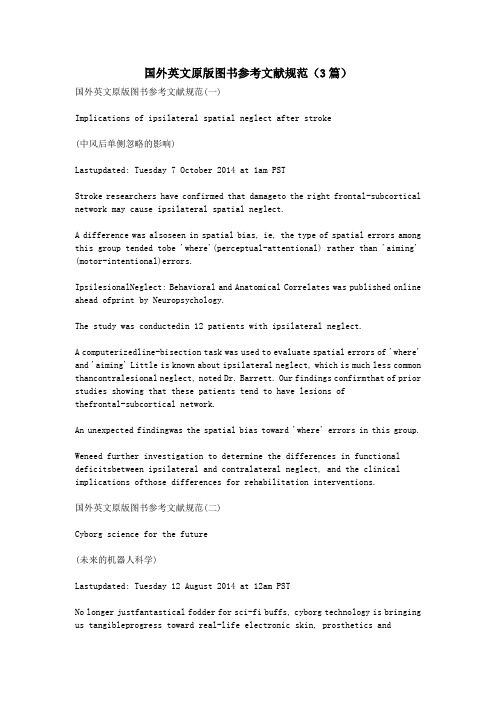
国外英文原版图书参考文献规范(3篇)国外英文原版图书参考文献规范(一)Implications of ipsilateral spatial neglect after stroke(中风后单侧忽略的影响)Lastupdated: Tuesday 7 October 2014 at 1am PSTStroke researchers have confirmed that damageto the right frontal-subcortical network may cause ipsilateral spatial neglect.A difference was alsoseen in spatial bias, ie, the type of spatial errors among this group tended tobe 'where'(perceptual-attentional) rather than 'aiming' (motor-intentional)errors.IpsilesionalNeglect: Behavioral and Anatomical Correlates was published online ahead ofprint by Neuropsychology.The study was conductedin 12 patients with ipsilateral neglect.A computerizedline-bisection task was used to evaluate spatial errors of 'where' and 'aiming' Little is known about ipsilateral neglect, which is much less common thancontralesional neglect, noted Dr. Barrett. Our findings confirmthat of prior studies showing that these patients tend to have lesions ofthefrontal-subcortical network.An unexpected findingwas the spatial bias toward 'where' errors in this group.Weneed further investigation to determine the differences in functional deficitsbetween ipsilateral and contralateral neglect, and the clinical implications ofthose differences for rehabilitation interventions.国外英文原版图书参考文献规范(二)Cyborg science for the future(未来的机器人科学)Lastupdated: Tuesday 12 August 2014 at 12am PSTNo longer justfantastical fodder for sci-fi buffs, cyborg technology is bringing us tangibleprogress toward real-life electronic skin, prosthetics andultraflexiblecircuits. Now taking this human-machine concept to an unprecedented level,pioneering scientists are working on the seamless marriage between electronicsand brain signaling with the potential to transform our understanding of howthe brain works - and how to treat its most devastating diseases.Their presentation tookplace at the 248th National Meeting & Exposition of the American ChemicalSociety (ACS), the world's largest scientific society.By focusing on thenanoelectronic connections between cells, we can do things no one has donebefore, says Charles M. Lieber, Ph.D. We're really going into a newsize regime for not only the device that records or stimulates cellularactivity, but also for the whole circuit. We can make it really look and behavelike smart, soft biological material, and integrate it with cells and cellularnetworks at the whole-tissue level. This could get around a lot of serioushealth problems in neurodegenerative diseases in the future.These disorders, such asParkinson's, that involve malfunctioning nerve cells can lead to difficultywith the most mundane and essential movements that most of us take for granted:walking, talking, eating and swallowing.Scientists are workingfuriously to get to the bottom of neurological disorders. But they involve thebody's most complex organ - the brain - which is largely inaccessible todetailed, real-time scrutiny. This inability to see what's happening in thebody's command center hinders the development of effective treatments for diseasesthat stem from it.By usingnanoelectronics, it could become possible for scientists to peer for the firsttime inside cells, see what's going wrong in real time and ideally set them ona functional path again.For the past severalyears, Lieber has been working to dramatically shrink cyborg science to a levelthat's thousands of times smaller and more flexible than other bioelectronicresearch efforts. His team has made ultrathin nanowires that can monitor andinfluence what goes on inside cells. Using these wires, they have builtultraflexible, 3-D mesh scaffolding with hundreds of addressable electronicunits, and they have grown living tissue on it. They have also developed thetiniest electronic probe ever that can record even the fastest signaling betweencells.Rapid-fire cellsignaling controls all of the body's movements, including breathing andswallowing, which are affected in some neurodegenerative diseases. And it's atthis level where the promise of Lieber's most recent work enters the picture.In one of the lab'slatest directions, Lieber's team is figuring out how to inject their tiny,ultraflexible electronics into the brain and allow them to become fullyintegrated with the existing b#from 国外英文原版图书参考文献规范(3篇)来自 end#iological web of neurons. They're currently inthe early stages of the project and are working with rat models.It's hard to saywhere this work will take us, he says. But in the end, I believeour unique approach will take us on a path to do something reallyrevolutionary.TitleNanoelectronicsmeetsbiology: From new tools to electronic therapeuticsAbstractNanoscale materialsenable unique opportunities at the interface between the physical and lifesciences, and the interfaces between nanoelectronic devices and cells, cellnetworks, and tissue makes possible communication between these systems at thelength scale relevant to biological function. In this presentation, thedevelopment of nanowire nanoelectronic devices and their application aspowerful tools for the recording and stimulation from the level of single cellsto tissue will be discussed. First, a brief introduction to nanowirenanoelectronic devices as well as comparisons to other tools will be presentedto illuminate the unique strengths and opportunities enabled by activeelectronic devices. Second, opportunities for the creation of powerful newprobes capable of intracellular recording and stimulation at scales heretoforenot possible with existing electrophysiology techniques will be discussed.Third, we will take an 'out-of-the-box' look and consider mergingnanoelectronics with cell networks in three-dimensions (3D). We will introducegeneral methods and provide examples of synthetic 'cyborg' tissues innervatedwith nanoelectronic sensor elements that enabling recording and modulating activityin 3D for these engineered tissues. In addition, we will discuss extension ofthese nanoelectronic scaffold concepts for the development of revolutionaryprobes for acute and chronic brain mapping as well as their potential as futureelectronic therapeutics. The prospects for broad-ranging applications in thelife sciences as the distinction between electronic and living systems isblurred in the future will be discussed.国外英文原版图书参考文献规范(三)例(1) (7)选自英国Edinburgh University Press出版的Modern North American Criticism and Theory: A Critical Guide。
外文参考文献格式模板
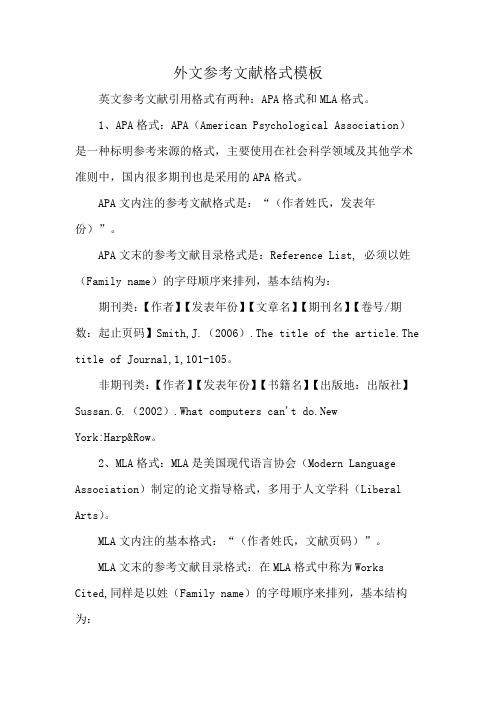
外文参考文献格式模板英文参考文献引用格式有两种:APA格式和MLA格式。
1、APA格式:APA(American Psychological Association)是一种标明参考来源的格式,主要使用在社会科学领域及其他学术准则中,国内很多期刊也是采用的APA格式。
APA文内注的参考文献格式是:“(作者姓氏,发表年份)”。
APA文末的参考文献目录格式是:Reference List, 必须以姓(Family name)的字母顺序来排列,基本结构为:期刊类:【作者】【发表年份】【文章名】【期刊名】【卷号/期数:起止页码】Smith,J.(2006).The title of the article.The title of Journal,1,101-105。
非期刊类:【作者】【发表年份】【书籍名】【出版地:出版社】Sussan.G.(2002).What computers can't do.NewYork:Harp&Row。
2、MLA格式:MLA是美国现代语言协会(Modern Language Association)制定的论文指导格式,多用于人文学科(Liberal Arts)。
MLA文内注的基本格式:“(作者姓氏,文献页码)”。
MLA文末的参考文献目录格式:在MLA格式中称为Works Cited,同样是以姓(Family name)的字母顺序来排列,基本结构为:期刊类:【作者】【“文章名”】【期刊名】【卷号或期数】【发表年份】起止页码】Nwezeh,C.E.“The Comparative Approachto Modern African Literature.”Year book of General and Comparative Literature 28(1979):22。
非期刊类:【作者】【书籍名】【出版地:出版社】【发表年份】Winfield,Richard w in Civil Society.Madison:U of Wisconsin P,1995。
外文译著参考文献要求

外文译著参考文献要求咱来说说外文译著参考文献的要求哈。
一、基本信息要全。
1. 原著信息。
首先得有原著作者的大名。
这就像你介绍一个朋友,得说出他是谁呀。
比如写[英]J.K.罗琳,让大家知道这书最初是出自谁的脑洞。
出版社也要写清楚。
不同的出版社可能会有不同的版本特点,比如企鹅出版社(Penguin Books)出的书,可能在装帧、编辑风格上和其他出版社有区别,写上出版社能让读者更全面地了解这个版本的背景。
2. 译者信息。
如果有译者写的译序或者译者的一些特殊说明,要是引用到了相关内容,也要在参考文献里体现一下。
就好像译者对这个作品的理解和解释也是这个译著的一部分财富,要好好记录。
3. 译著版本信息。
译著的出版年份和出版社也要写明白。
这和原著的出版信息一样重要。
也许译著是在原著出版多年后才出来的,而且不同出版社的译著可能会有不同的译文质量、排版风格之类的,这些信息能让读者更好地找到你参考的那个具体版本。
如果有版次的话,也得写上。
比如是第1版还是第2版,版次的不同可能意味着内容有修订、补充之类的,这对准确引用和研究也很关键。
二、引用规范要遵守。
1. 引用页码准确。
2. 引用内容的完整性。
不要断章取义地引用。
要按照原著或者译著作者的本意来引用内容,不能为了迎合自己的观点就只截取一部分文字,歪曲人家的意思。
就像你不能把别人说“我喜欢在晴天散步,但有时候也会在小雨中走走”,只截取“我喜欢在晴天散步”,然后说这个人只喜欢晴天散步,这是不道德的引用方式。
三、格式统一要注意。
1. 整体格式。
在一篇文章或者论文里,所有的外文译著参考文献格式要保持一致。
不能这个译著参考文献是一种写法,那个又是另一种写法。
就像一群人排队,大家都得按照同样的规则站好,要么按照作者书名出版社出版年份这样的顺序,要么按照其他统一的格式,反正不能乱套。
2. 标点符号使用。
标点符号也要规范。
书名要用书名号(如果是中文格式的话)或者斜体(如果是英文格式)。
- 1、下载文档前请自行甄别文档内容的完整性,平台不提供额外的编辑、内容补充、找答案等附加服务。
- 2、"仅部分预览"的文档,不可在线预览部分如存在完整性等问题,可反馈申请退款(可完整预览的文档不适用该条件!)。
- 3、如文档侵犯您的权益,请联系客服反馈,我们会尽快为您处理(人工客服工作时间:9:00-18:30)。
[1]G. Einsele a, SK. Chough b, T. Shiki,1996. Depositional events and their records-an introduction[J].Sedimentary Geology, 104:l-9.[2]Kauffman E.G.,Elder W.P. and Sageman B.B..High-resolution correlation: a new tool in chronostratigraphy. In: Einsele et al. (Editor), Cycle and Events in Stratigraphy. Springer-Verlag, Berlin, Heidelberg, 1991,798-819.[3]Bruce C. Heezen, D.B. Ericson, Maurice Ewing.Further evidence for a turbidity current following the 1929 Grand banks earthquake[J].Deep Sea Search.1954,1(4):193-202.[4]Cita and Lucchi.Marine Geology[J].Seismicity and sedimentation.1984, 55(1-2):VII–X.[5]Frank R Ettensohn,Carlton E Brett. Stratigraphic evidence from the Appalachian Basin for continuation of the Taconian orogeny into Early Silurian time[J]. Physics and Chemistry of the Earth.2002,27(1): 279-288.[6]Fabrizio Storti, Paola Vannucchi.Preface[J].Sedimentary Geology.2007,196(1-4):1-3.[7]R. Bernhart Owen;Robin W. Renaut and Michael G. te Miocene lacustrine sedimentation in the Mytilinii Basin, Samos Island, Greece[J].Journal of Paleolimnology.2011,46(1):151-166.[8]DengWeidong, YangBaoguo, WuXiaogen. 1997. Studies of storm deposits in China:a review. Continental Shelf Research, 17(13): 1645-1658.[9]H.N. Bhattacharya, Biplab Bhattacharya, Indranil Chakraborty, Abhijit Chakraborty.Sole marks in storm event beds in the Permo-Carboniferous Talchir Formation, Raniganj Basin, India[J].Sedimentary Geology.2004, 166(3-4):209–222. [10]Shu Degan , Conway Morris S , Zhang Xingliang .A Pikaialike chordate from the Lower Cambrian of China[J]. Nature.1996a,384 : 156 -157.[10]Shu Degan, Conway Morris S, Zhang Xingliang, et al.. A pipiscid-like fossil from the Lower Cambrian of South China[J]. Nature, 1999a,400: 746 -749.[11]Becker L, Poreda R J, Hunt A G, et al . . Impact event at the Permian-Triassicboundary: Evidence from extraterrestrial noble gases in fullerenes[J]. Science, 2001, 291 (5508): 1530-1533.[12]Bambach R K. . Phanerozoic biodiversity mass extinctions[J]. Annu Rev Earth Planet Sci..2006, 34: 127-155.[13]Alvarez L W, Alvarez W, Asaro F, et al.. Extraterrestrial Cause for the Cretaceous-Tertiary Extinction[J]. Science.1980,208: 1095-1108.[14]Wolfgang Stinnesbeck, Gerta Keller, Peter Schulte, Doris Stüben, Zsolt Berner, Utz Kramar, JoséGuadalupe Lopez-Oliva.The Cretaceous–Tertiary (K/T) boundary transition at Coxquihui, state of Veracruz, Mexico: evidence for an early Danian impact event?[J]Journal of South American Earth Sciences .2002,15 (5) :497–509. [15]S. J. Nichols and S. G. Hagemann[16]P. Farrimond, G. Eglinton, S.C. Brassell, H.C. Jenkyns.The Toarcian black shale event in northern Italy[J].Organic Geochemistry.1988,13(4-6):823-832.[17]Röhl, Hans-Joachim;Schmid-Röhl, Annette;Oschmann, Wolfgang;Frimmel, Andreas.Erratum to “The Posidonia Shale (Lower Toarcian) of SW-Germany: an oxygen-depleted ecosystem controlled by sea level and palaeoclimate”[J].Palaeogeography, Palaeoclimatology, Palaeoecology.2001,169(3-4):271.[18]Anthony S. Cohen;Angela L. Coe and David B. Kemp.The Late Palaeocene–Early Eocene and Toarcian (Early Jurassic) carbon isotope excursions: a comparison of their time scales, associated environmental changes, causes and consequences[J].Journal of the Geological Society.2007,164(6):1093-1108.[19]Bryony A. Caswell;Angela L. Coe;Anthony S. Cohen.New range data for marine invertebrate species across the early Toarcian (Early Jurassic) mass extinction[J].Journal of the Geological Society.2009,166(5):859-872.[20]Mattioli[21]Suan[22]Hoffman P F, Li Zhengxiang. A palaeogeographic context for Neoproterozoic glaciation[J]. Palaeogeogrpahy.2009,277: 158-172.[23Ramzi Gharsalli, Taher Zouaghi, Mohamed Soussi, Riadh Chebbi, Sami Khomsi, Mourad Bédir.Seismic sequence stratigraphy of Miocene deposits related to eustatic,tectonic and climatic events, Cap Bon Peninsula, northeastern Tunisia[J].Comptes Rendus Geoscience.2013,345(9-10):401-417.[24]Yuzhu Zhang;Chun Chang Huang;Jiangli Pang;Xiaochun Zha;Yali Zhou;Xiaqing Wang.Holocene palaeoflood events recorded by slackwater deposits along the middle Beiluohe River valley, middle Yellow River basin, China[J].Boreas.2015,44(1):127-138.[25]Keim[26]Hornung[27]David Z. Piper.Rare earth elements in the sedimentary cycle: A summary[J].Chemical Geology.1974,14(4):285-304.[28]Mclennan S M. 1989. Rare earth elements in sedimentary rocks: influence of provenance and sedimentary processes. In: Lipin B R, Mckay G R, eds. Geochemistry and mineralogy of rare earth elements. Reviews in Mineralogy, 21: 169-200.[29]Mclennan S M, Hemming S, McDanial D K, et al.. Geochemical approaches to sedimentation, provenance, and tectonics[J]. Geological Society of American Special Paper.1993,284: 21-40.[30]Bhatia M R..Plate tectonics and geochemical composition of sandstones[J].Journal of Geology, 1991,91:611-629.。
